My New Sigma 50mm f1.4 EX DG HSM Test
 Wednesday, May 16, 2012 at 8:07PM
Wednesday, May 16, 2012 at 8:07PM I bought a new Sigma 50mm f1.4 lens last night with the intention of it being my Bangkok walking around lens for night street work. I bought mine from a reputable dealer in Ponthip Plaza and promptly went out to do some street testing in the early evening. I brought along my trusty "plastic fantastic" Canon 50mm f1.8 lens for some comparison shots. As soon as it got dark I realized my copy of the Sigma 50mm was front focusing to a severe degree. I walked back to the shop and they immediately replaced it with another copy . . . the second copy is very sharp and focuses perfectly on my subject. It must be remembered that when shooting at anything under f2.8 the depth of feild is extremely narrow ("paper thin at f1.4) on ANY lens from ANY manufacturer. That being said, I was extremely happy with the shots I took while walking around the Central World area of Bangkok with my new lens.
Reproduced below are some HAND HELD (that's the idea of a "walking around lens," no?) photos I took with my Canon 5D Mark II full frame camera body and my new Sigma 50mm f1.4 EX DG HSM lens: The top shots are Canon Raw Files converted to JPEG and then saved as 850px wide JPEG files without any adulteration either in the camera or in PhotoShop 5.5. The bottom shots are actual pixels at 100% converted from the Canon Raw Files cropped at 850px X 850px and not adulterated in the camera or in PhotoShop 5.5.
Cropping more than actual pixels (100%) makes no sense in a "for low light conditions" lens. If you want detail from a long distance from your subject, then get a longer lens, like the Sigma/Canon 85mm f1.4, or the Canon 70-200 L II f2.8. If you are going to print from Raw files, the 5D Mark II produces 5616X3744 pixel images from the camera . . . but, of course, you would correct/sharpen the images before printing. I have reproduced the files as they have come out of the camera.
At the bottom of this post are five images that have been post-processed (and reduced to the 850 pixel-width I use I this blog) to give you an idea of why you would want a 50mm f1.4 lens in your bag in the first place. The Sigma 50mm performs beautifully.
[April 2014 update: There is now an excellent dpreview lab test of this outstannding lens now available on their site.]

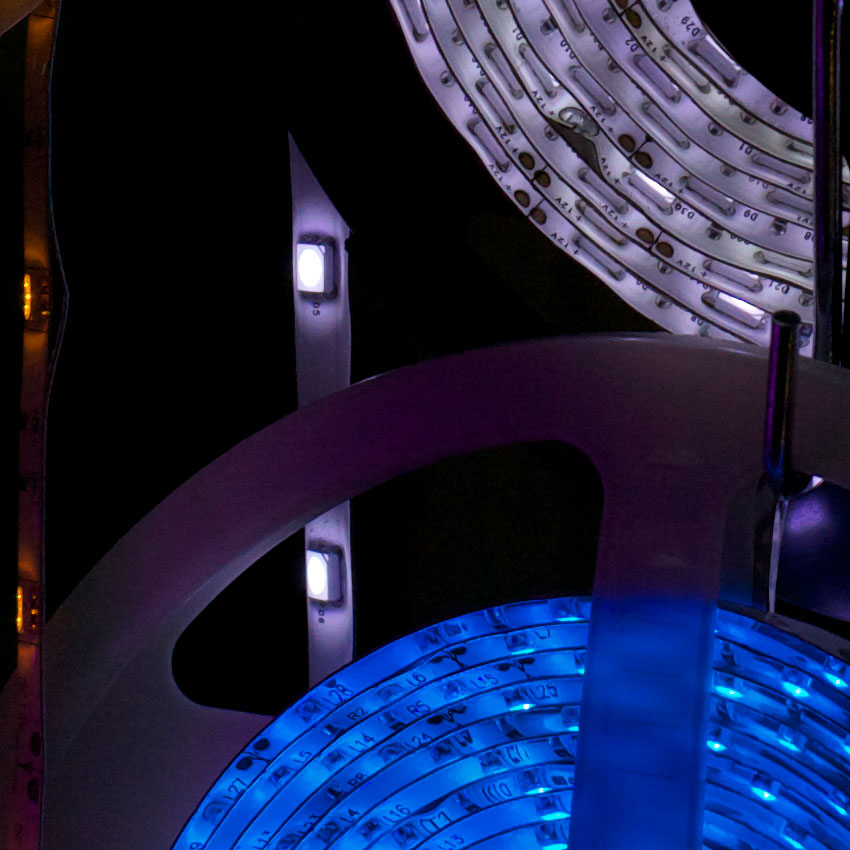
Above shot at f6.3.

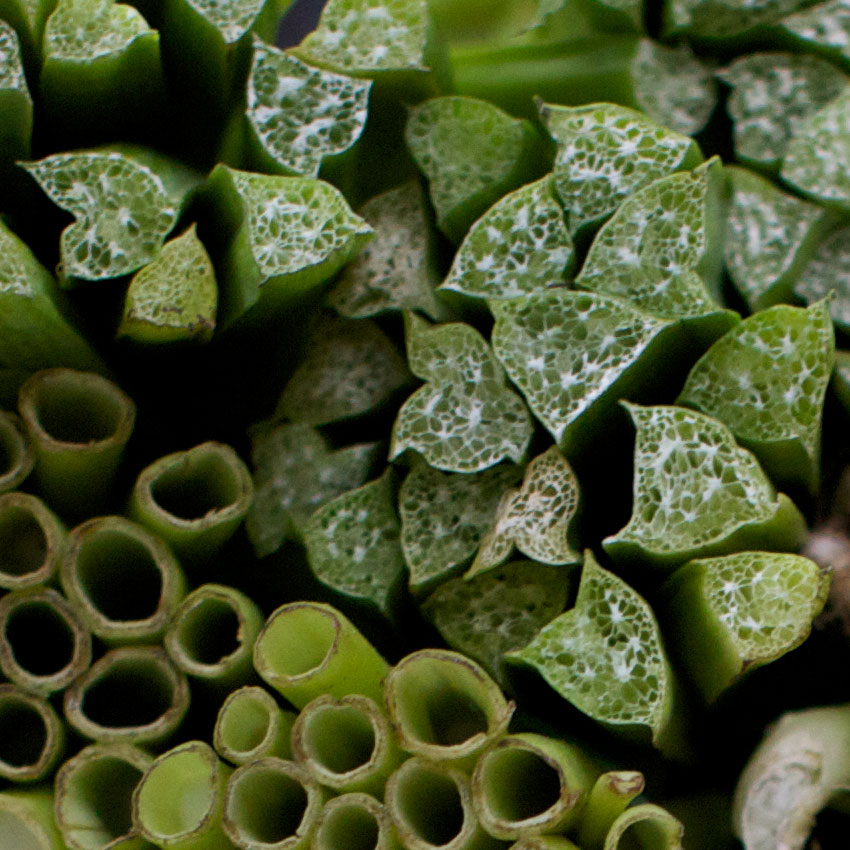 Above shot at f2.8.
Above shot at f2.8.

 Above shot at f2.8.
Above shot at f2.8.
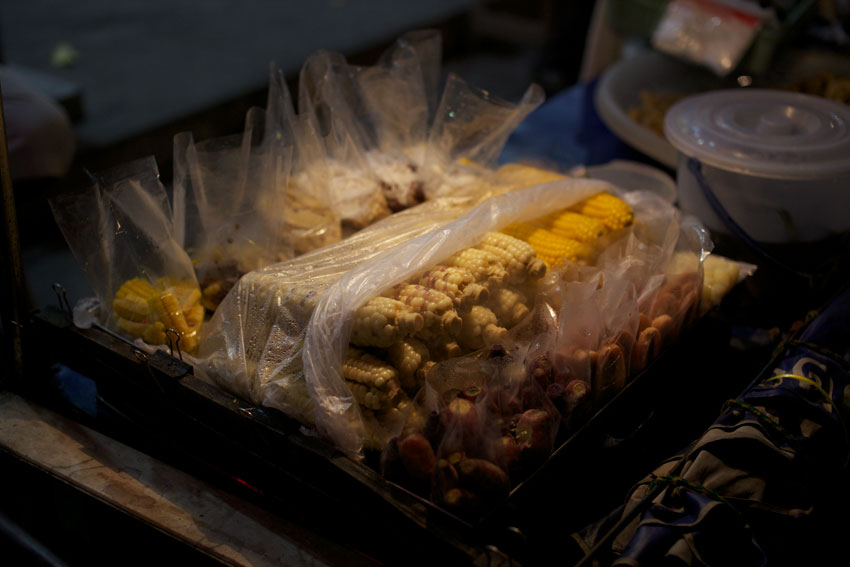
 Above shot at f2.2.
Above shot at f2.2.
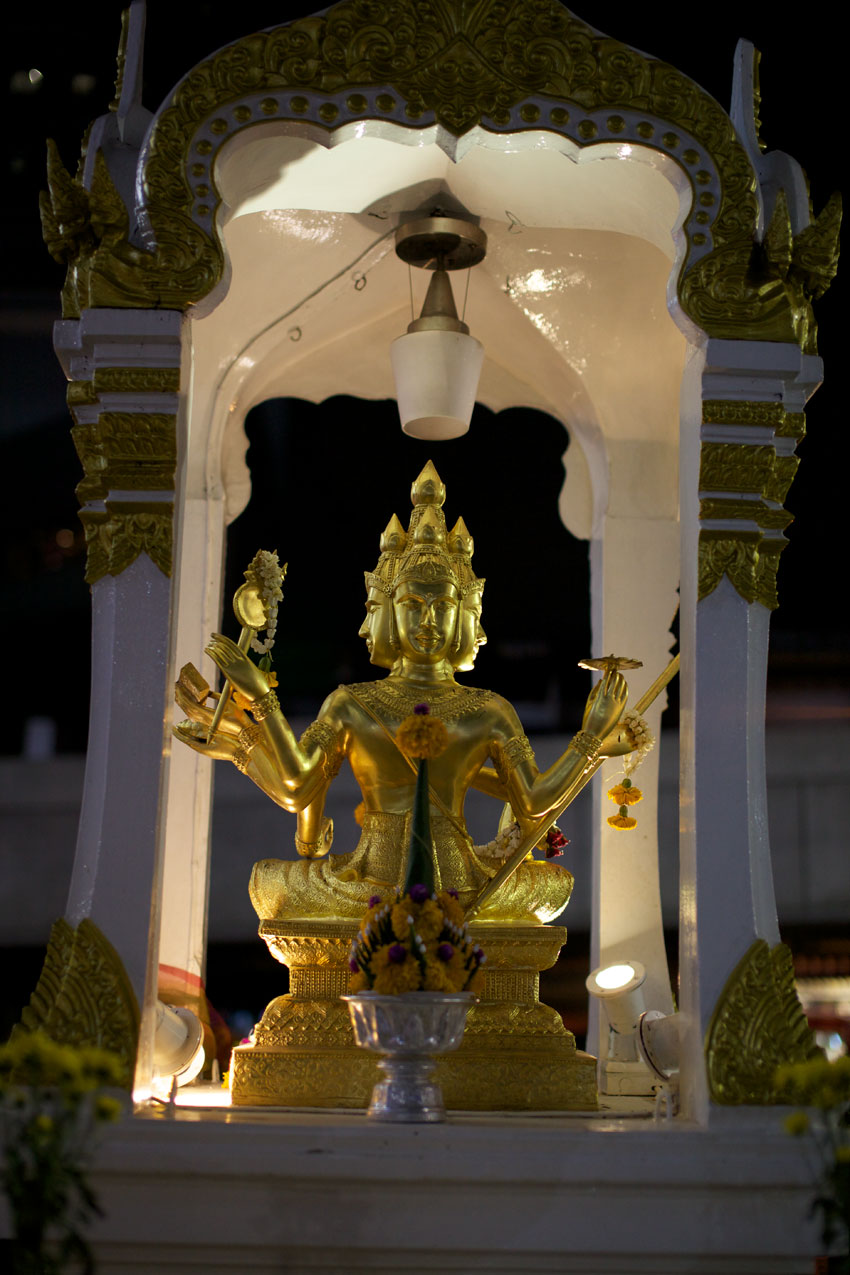
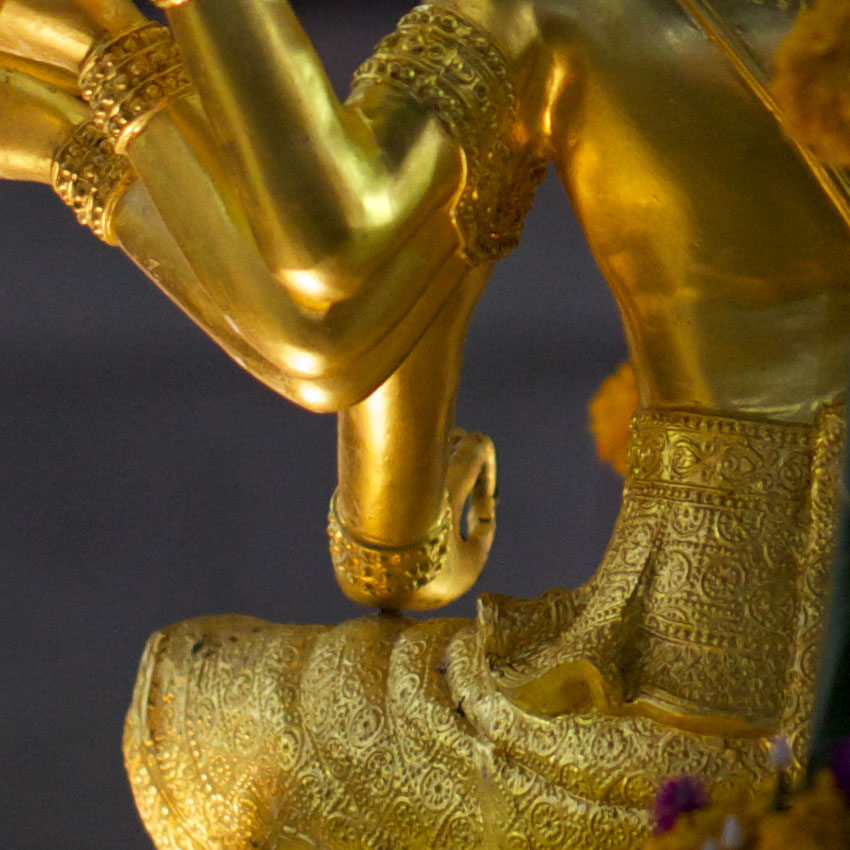 Above shot at f1.8.
Above shot at f1.8.
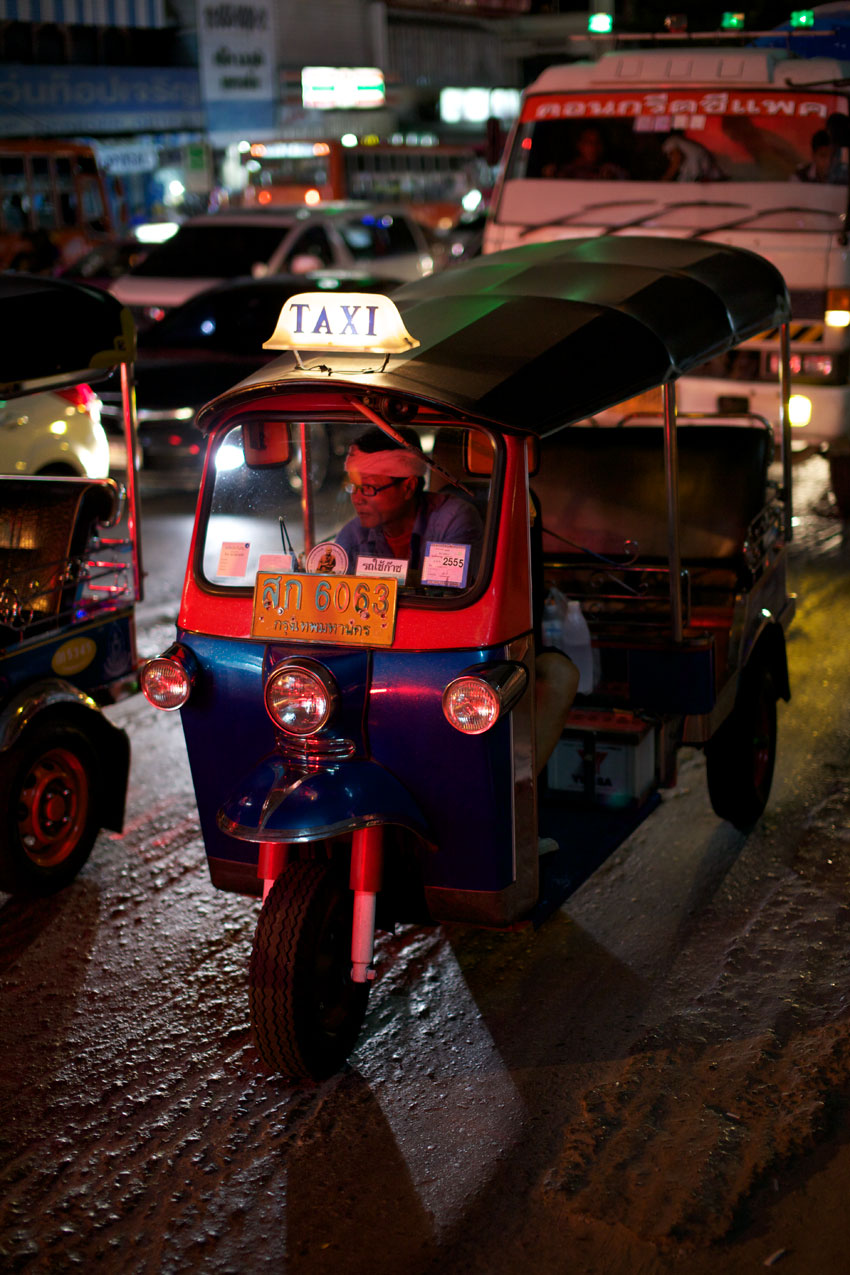
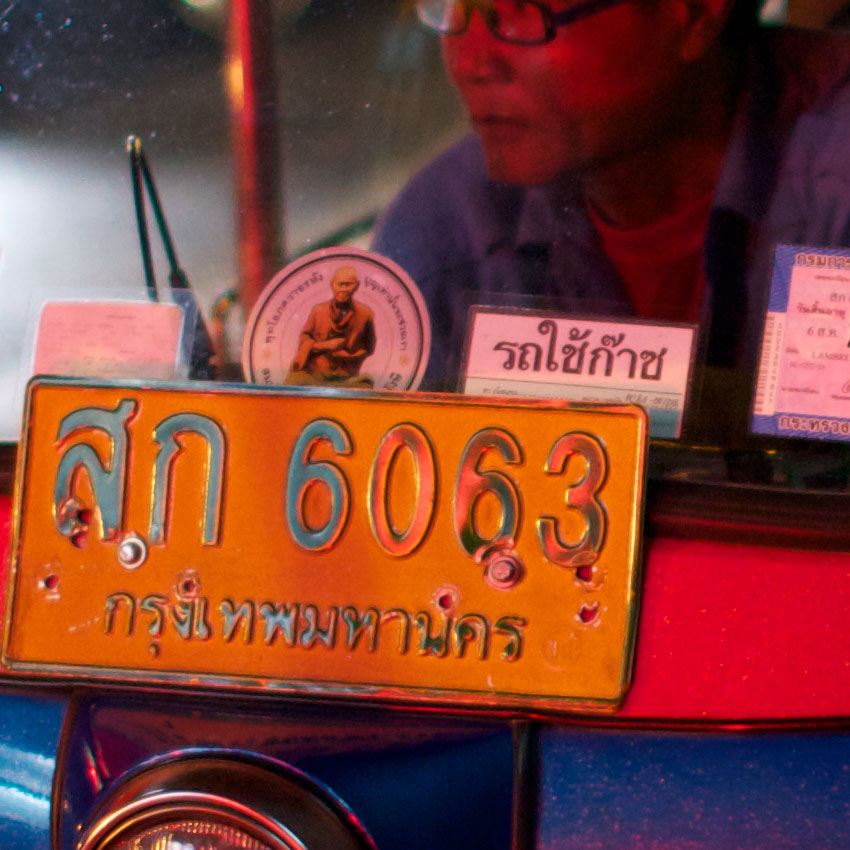 Above shot at f1.4 - HAND HELD !!!!!
Above shot at f1.4 - HAND HELD !!!!!
---------------------------------------------------
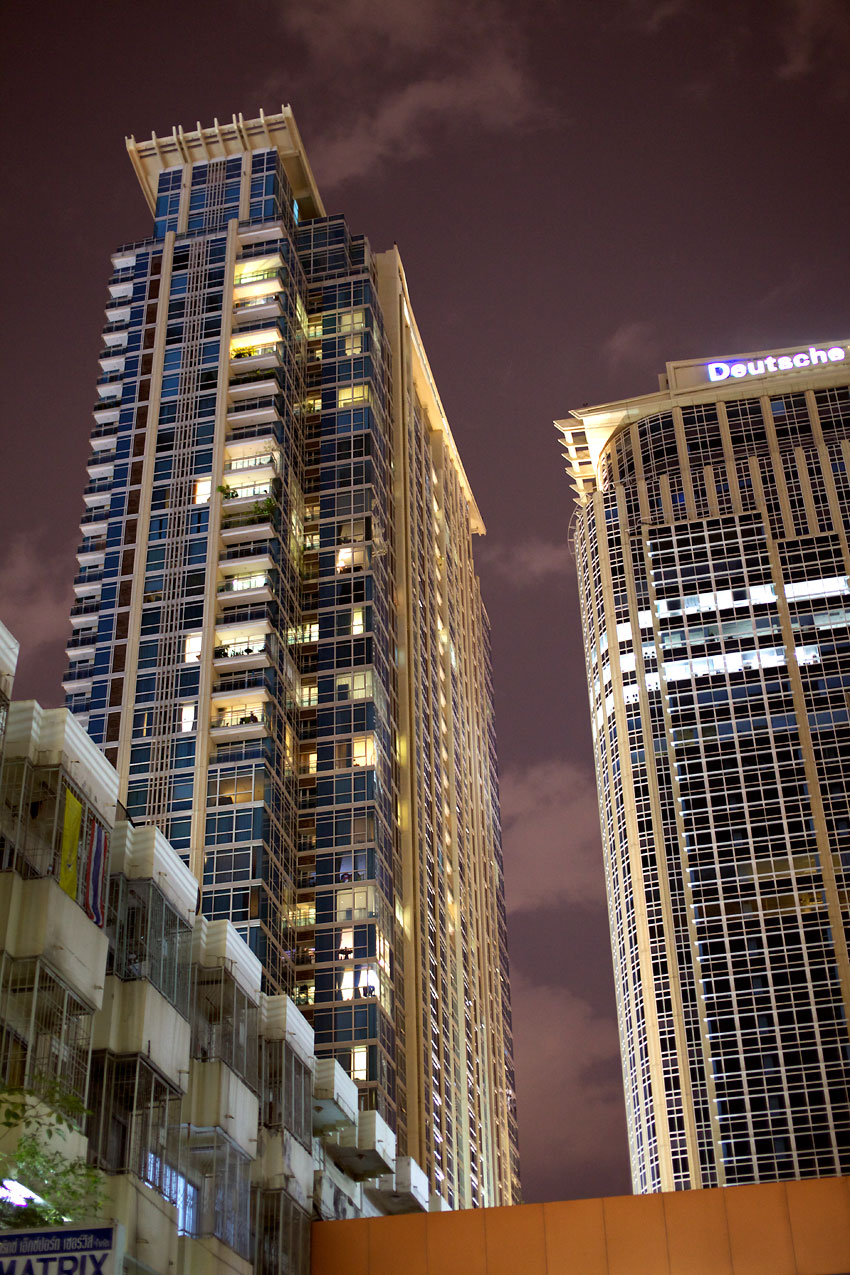 Tall buildings in Bangkok at night, hand held. This is why I have an f1.4 lens.
Tall buildings in Bangkok at night, hand held. This is why I have an f1.4 lens.
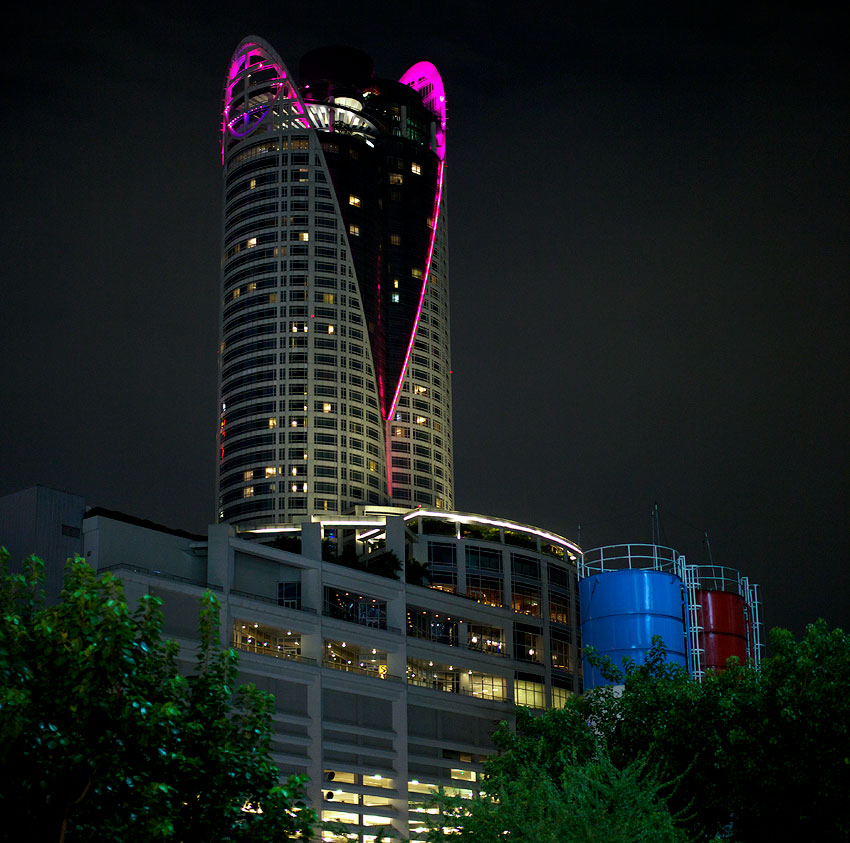 For this shot I jammed my camera up against a light pole for stability, but the ability of the lens to capture so much light made for beautiful detail in the shadows at such low light.
For this shot I jammed my camera up against a light pole for stability, but the ability of the lens to capture so much light made for beautiful detail in the shadows at such low light.
 A lot of people do not know that Bangkok is crisscrossed with canals that still accomodate canal taxis. This is an available light photo of a MOVING boat in the semi dark. I have the camera resting on the bridge railing for stability. Set your camera to apature priority (f1.4) and the camera will find the fastest shutter speed.
A lot of people do not know that Bangkok is crisscrossed with canals that still accomodate canal taxis. This is an available light photo of a MOVING boat in the semi dark. I have the camera resting on the bridge railing for stability. Set your camera to apature priority (f1.4) and the camera will find the fastest shutter speed.
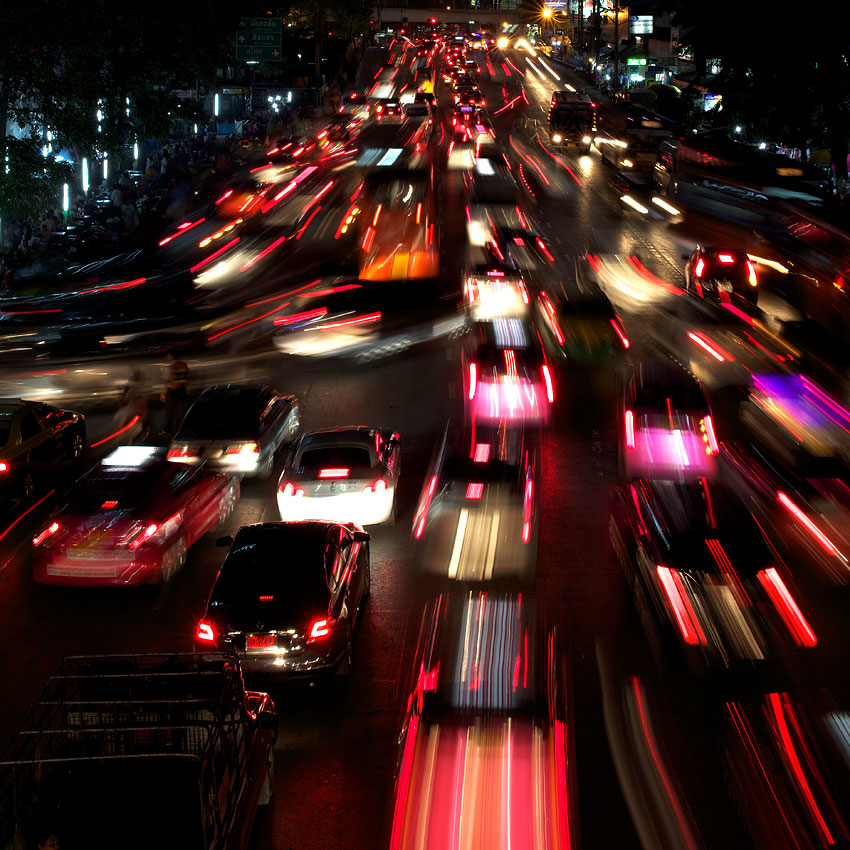 I am on a pedestrain cross-over with the camera against a bridge roof upright. The point here is the dynamic range a peice of big glass can capture. ISO 100, f.11.
I am on a pedestrain cross-over with the camera against a bridge roof upright. The point here is the dynamic range a peice of big glass can capture. ISO 100, f.11.
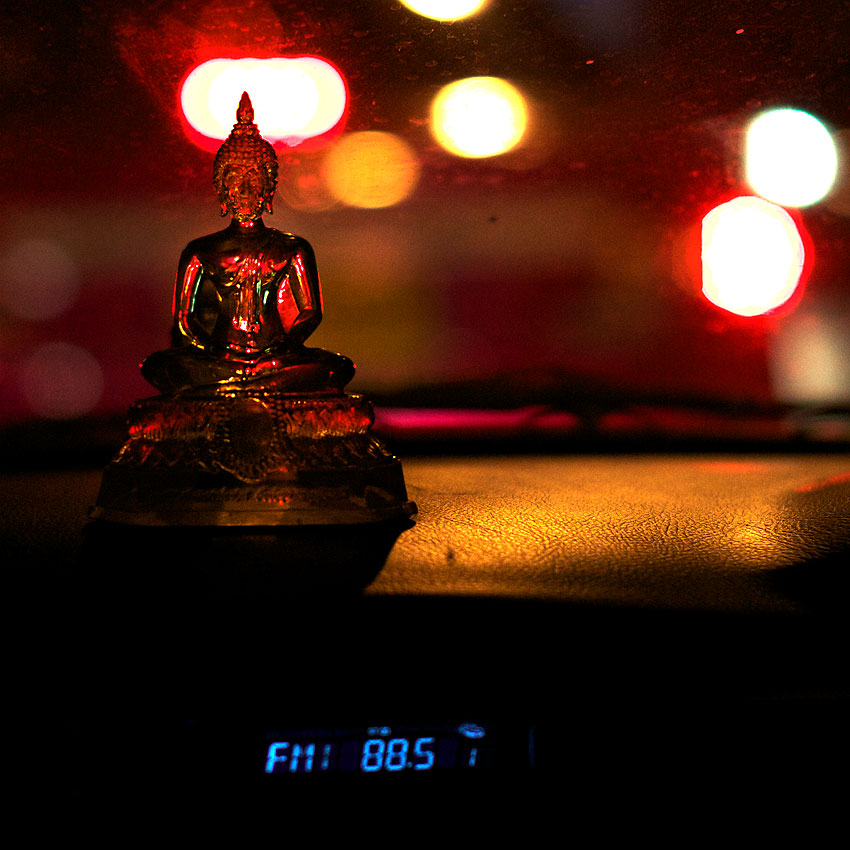 This is my best example of why I have an f1.4 lens: I am in the back of a MOVING TAXI going home and leaned forward to take this shot of the ubiquiteous Buddha-on-the-dashboard . . . an impossible shot. This is a cropped image. Remarkable.
This is my best example of why I have an f1.4 lens: I am in the back of a MOVING TAXI going home and leaned forward to take this shot of the ubiquiteous Buddha-on-the-dashboard . . . an impossible shot. This is a cropped image. Remarkable.
 Dr. Jeff Harper
Dr. Jeff Harper
I traded this excellent lens in on a more excellent lens: the Sigma 35mm f1.4 DG HMS Art Series lens -- as soon as it came out. The 50mm was a great low light lens, but the 35mm is superior. It is so sharp and quiet. It's a perfect lens, my best lens by far. It is so good that dpreview.com said, "Every now and then we come across a camera or lens that hits a sweet spot of image quality, usability and price that makes it an easy recommendation. The Sigma 35mm F1.4 DG HSM is just such a beast - it manages the impressive trick of being substantially cheaper than the camera manufacturers' equivalents while matching or beating them optically. If you're after a top quality fast prime at this focal length it should be right at the top of your short list, and it easily earns our top award." (citation)
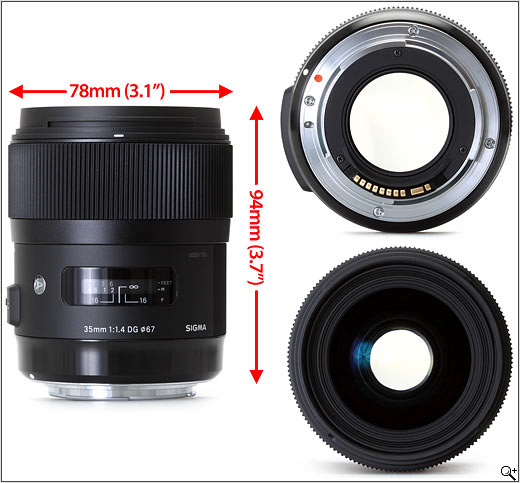
Deconstructing Monkeytown: Lopburi as Idea
 Sunday, May 30, 2010 at 6:00PM
Sunday, May 30, 2010 at 6:00PM Only a 90 mnute drive north of Bangkok . . . . . but a world away!
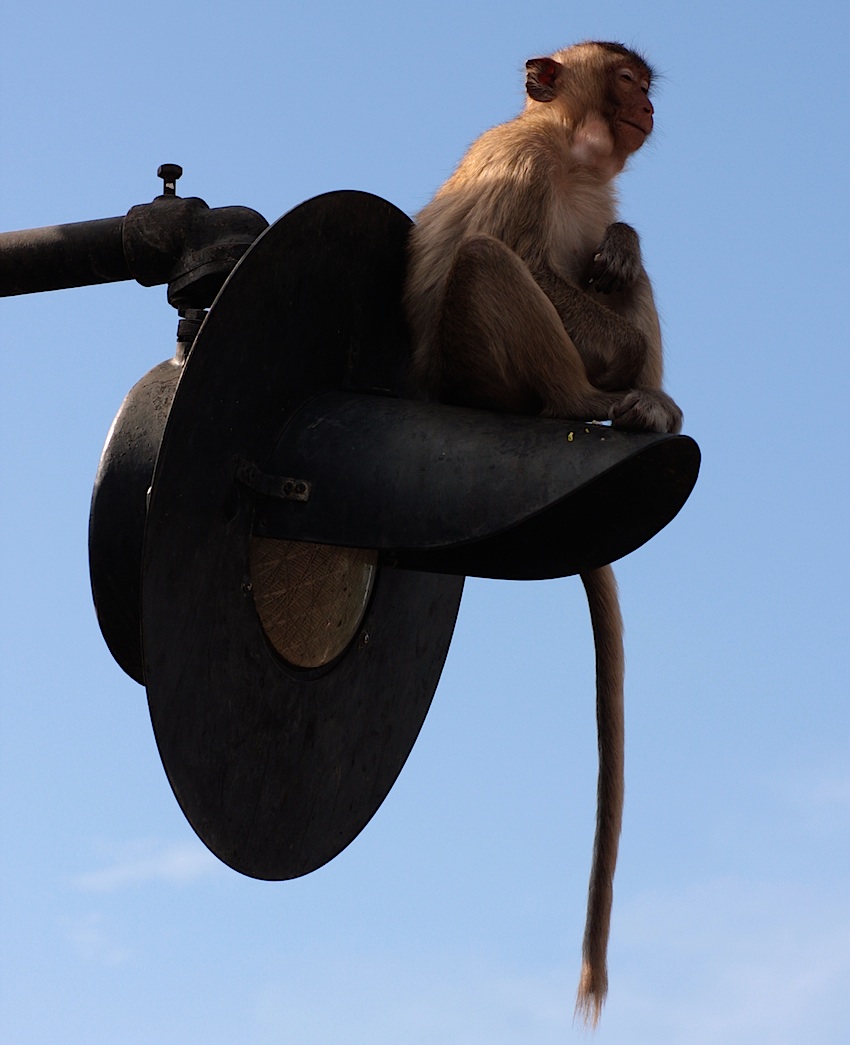 Lopburi is has a Monkey Temple, but the monkeys spill over into the nearby commercial district.
Lopburi is has a Monkey Temple, but the monkeys spill over into the nearby commercial district.
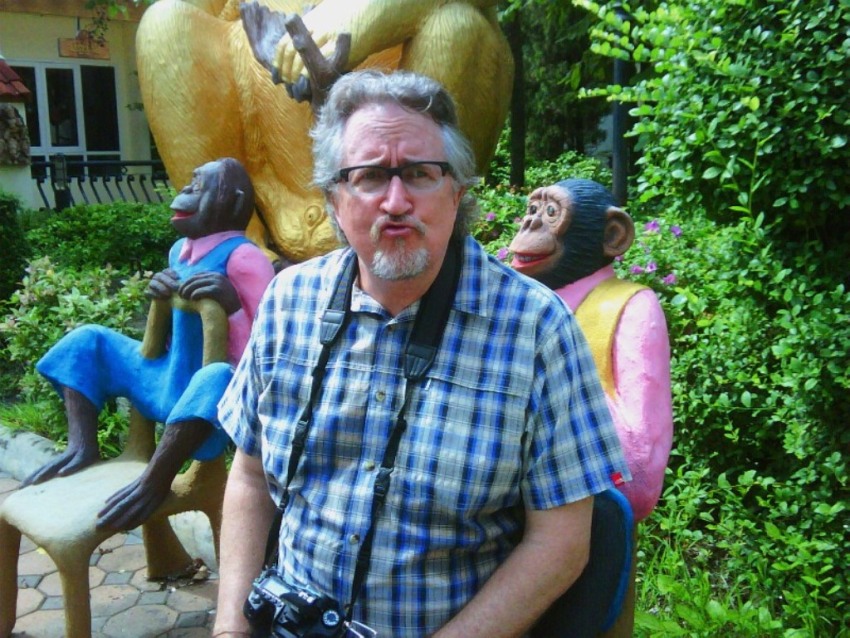 Everything in Lopbury is monkey-themed. Even the visitors.
Everything in Lopbury is monkey-themed. Even the visitors.
 "Monkeys are known for stealing food, yet . . . "
"Monkeys are known for stealing food, yet . . . "
 Very healthy coats on these sacred monkeys.
Very healthy coats on these sacred monkeys.
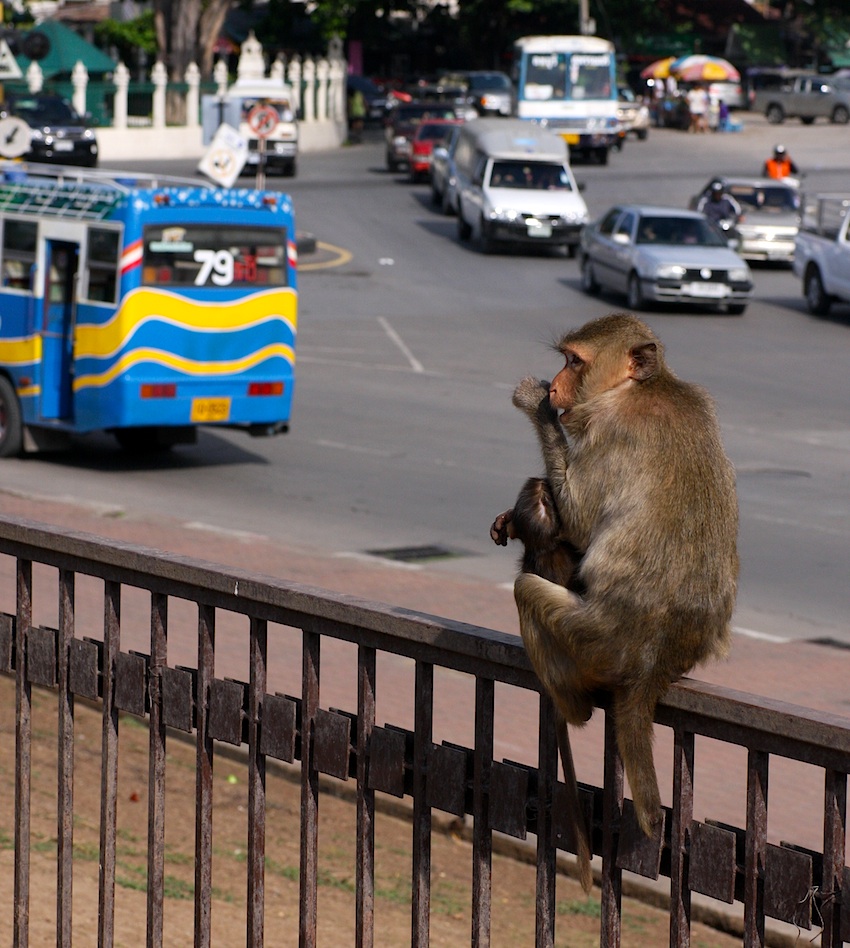 Do the regular passengers of Bus 79 even see the monkeys?
Do the regular passengers of Bus 79 even see the monkeys?
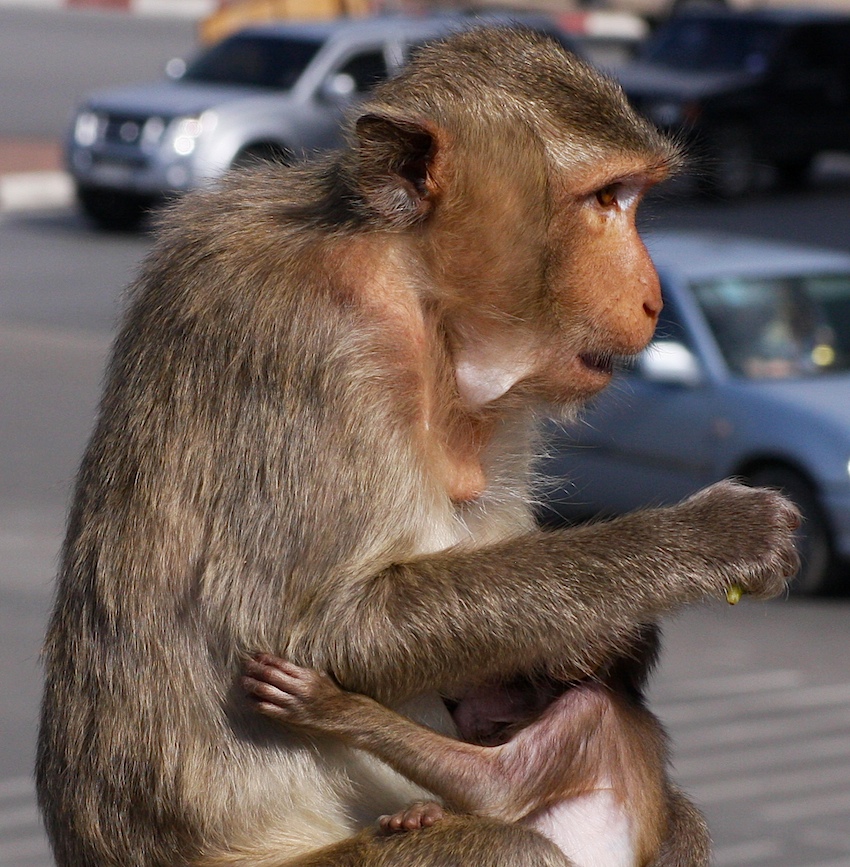 Do the temple monkeys even see the Bus 79 any more?
Do the temple monkeys even see the Bus 79 any more?
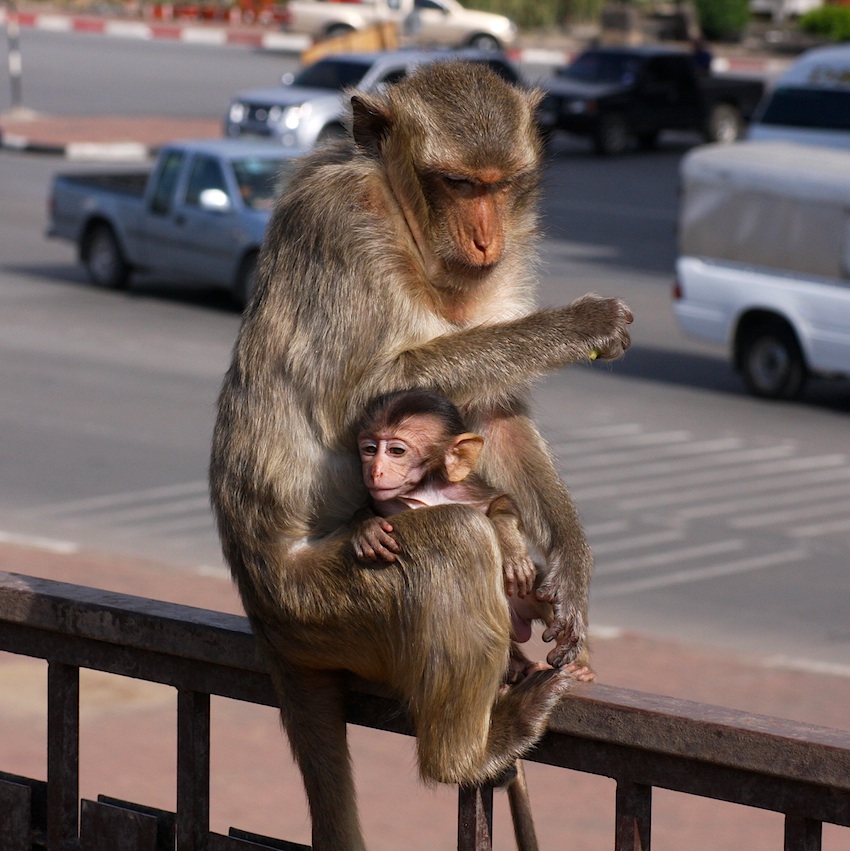 Comfort in a mother's arms.
Comfort in a mother's arms.
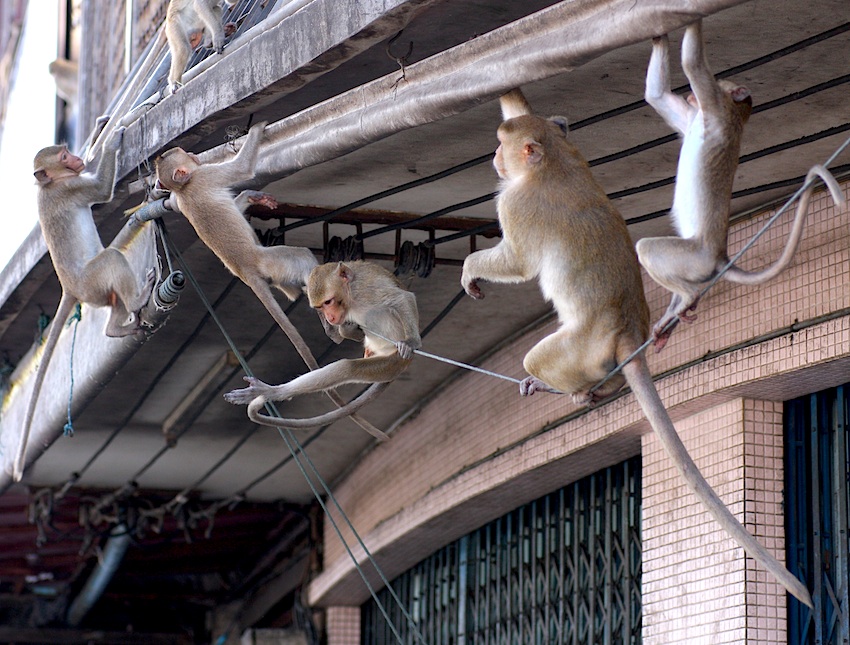 Electricity! No problem.
Electricity! No problem.
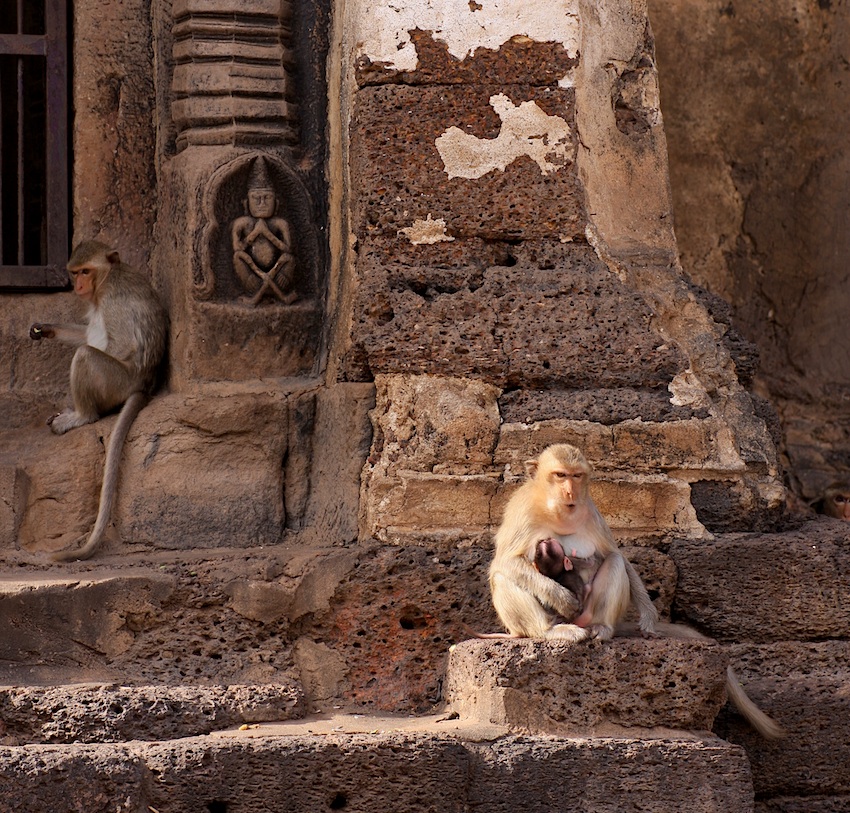 For 250 years this scene has endured.
For 250 years this scene has endured.
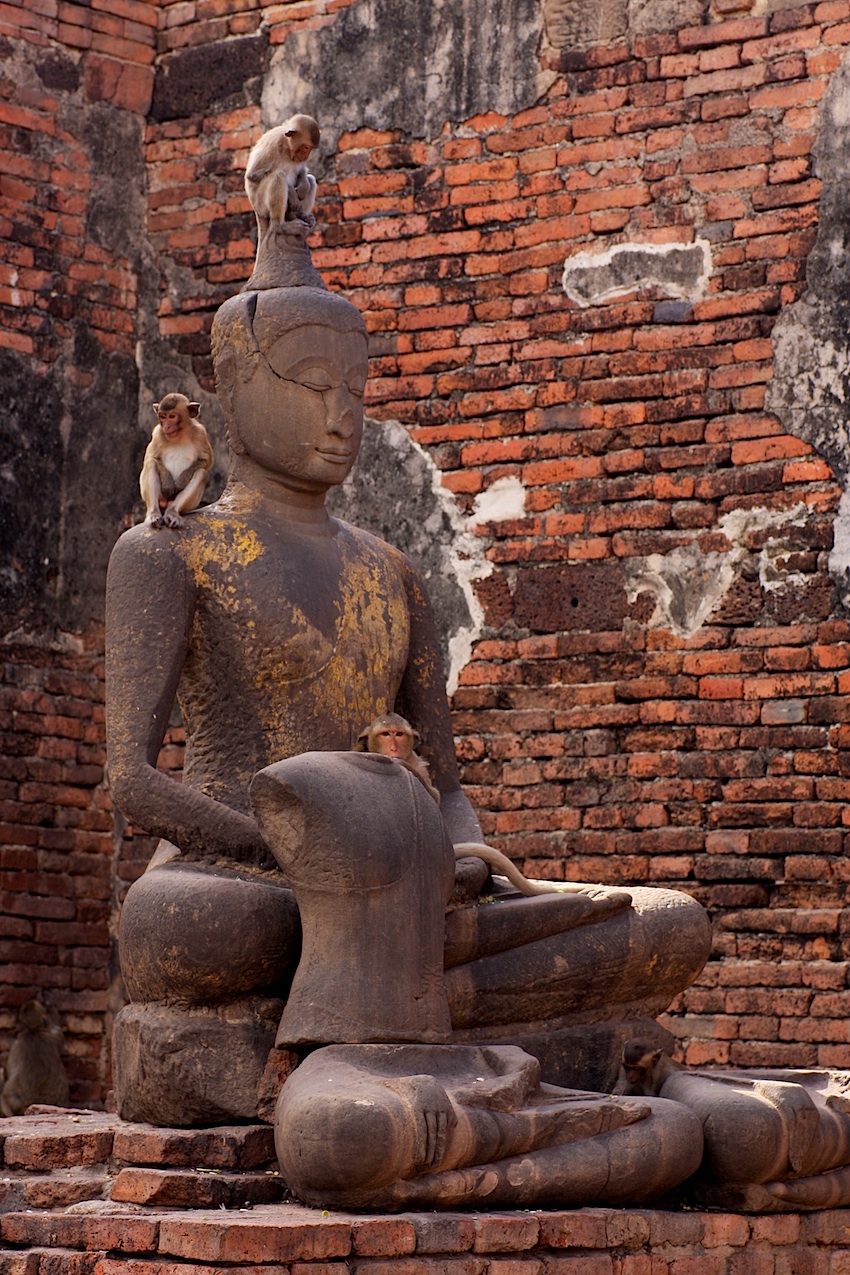 The most difficult of Mara's temptations is, of course, MonkeyMind.
The most difficult of Mara's temptations is, of course, MonkeyMind.
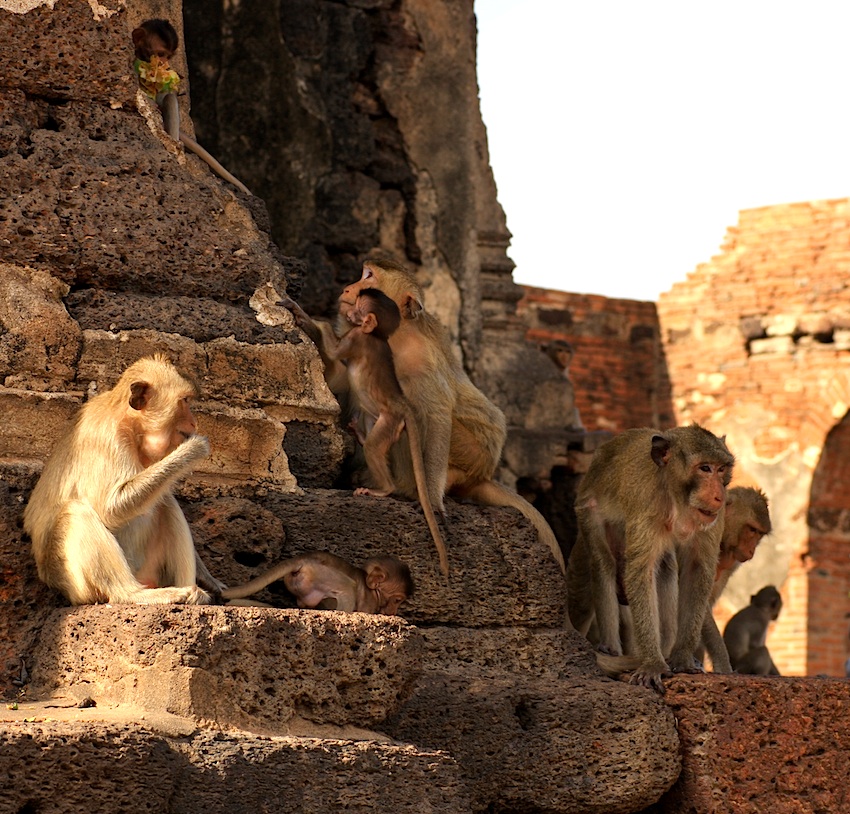 Life goes on within you and without you.
Life goes on within you and without you.
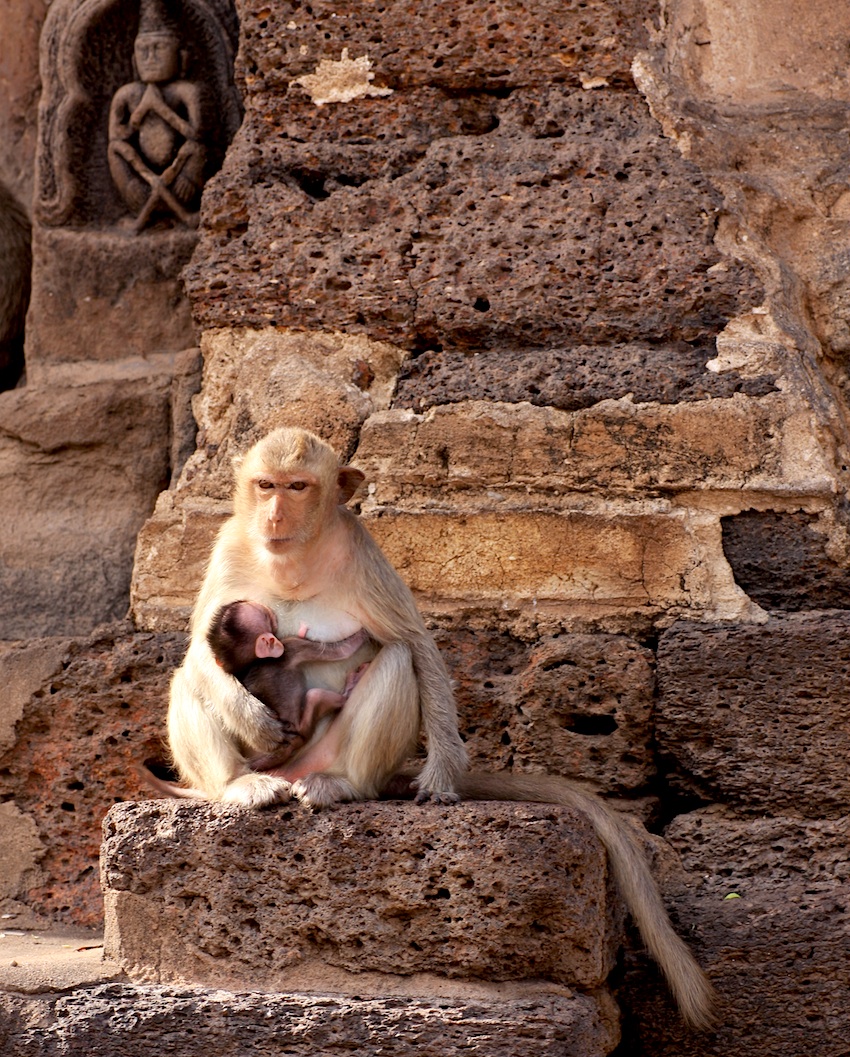 Contemplative motherhood, simian style.
Contemplative motherhood, simian style.
A Morning at the Bira Road Race Circuit in Pattaya, Thailand
 Sunday, May 9, 2010 at 12:02PM
Sunday, May 9, 2010 at 12:02PM 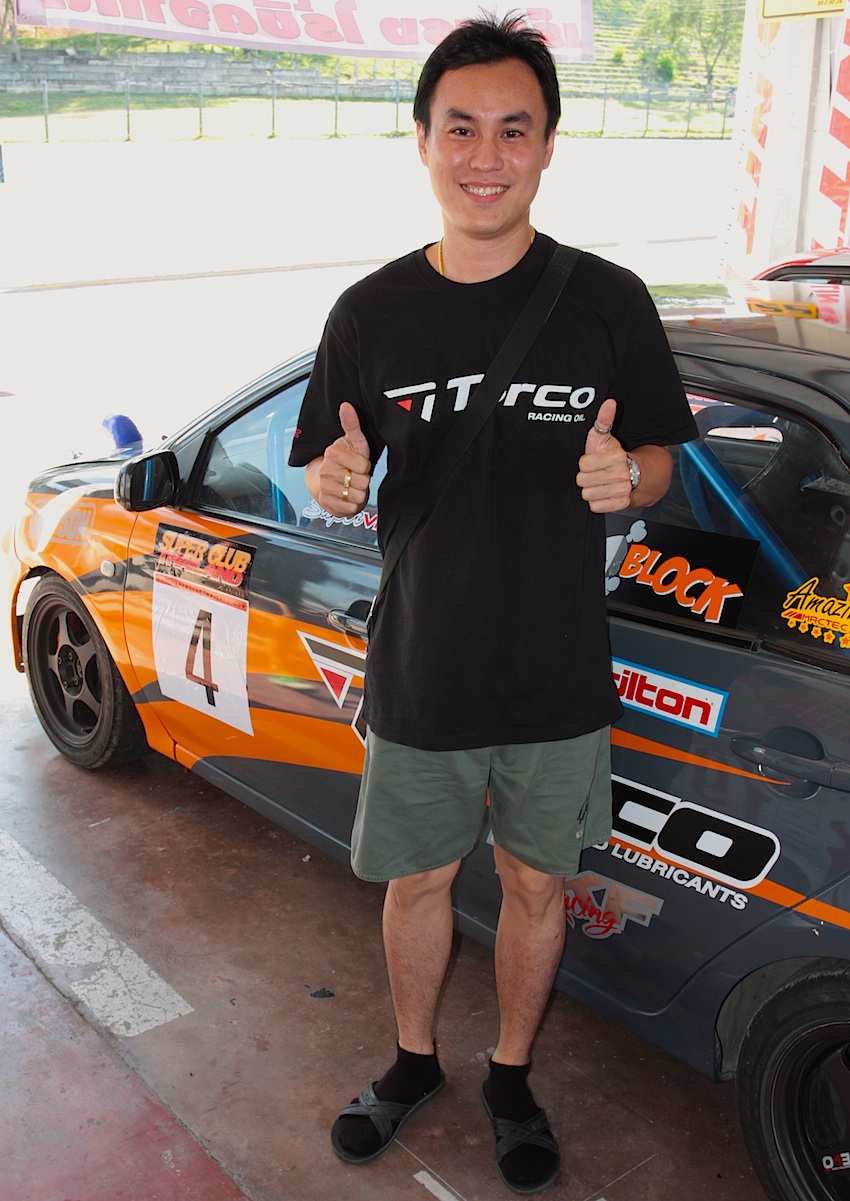 I spent the morning of Saturday, May 8, 2010 at the Bira Circuit in Pattaya, Thailand with my good friend and racing buddy, Khun Mac. He has his own company, MacTec, which is the major importer of race car parts to Thailand, in addition to being the Torco Oil franchisee in Thailand. I could not be racing at all if it weren't for Mac. Mac races in a "one make" class where limited modifications and weight is enforced. On this day he qualified first in his class.
I spent the morning of Saturday, May 8, 2010 at the Bira Circuit in Pattaya, Thailand with my good friend and racing buddy, Khun Mac. He has his own company, MacTec, which is the major importer of race car parts to Thailand, in addition to being the Torco Oil franchisee in Thailand. I could not be racing at all if it weren't for Mac. Mac races in a "one make" class where limited modifications and weight is enforced. On this day he qualified first in his class.
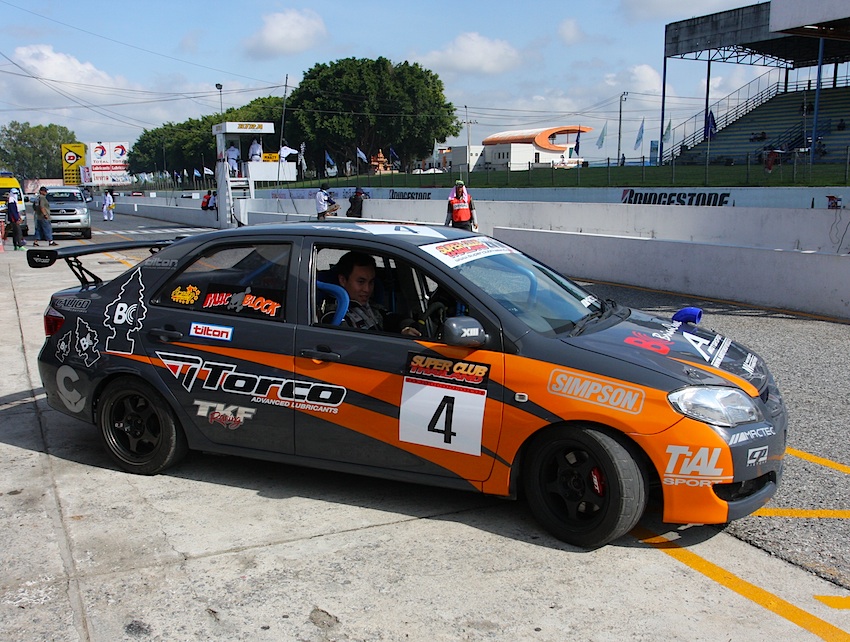 This is Mac's race car leaving his pit. It was over 38C (100f) with high humidity at 9:00am when he took to the track.
This is Mac's race car leaving his pit. It was over 38C (100f) with high humidity at 9:00am when he took to the track.
 Mac was off to a very good start until another racer banged his front fender causing both a flat tire and a bent front suspension (tie rod). After a quick pit stop to change the tire, he rejoined the race in last position, but due to the bent suspension, Mac "couldn't steer", an important aspect of race car control.
Mac was off to a very good start until another racer banged his front fender causing both a flat tire and a bent front suspension (tie rod). After a quick pit stop to change the tire, he rejoined the race in last position, but due to the bent suspension, Mac "couldn't steer", an important aspect of race car control.
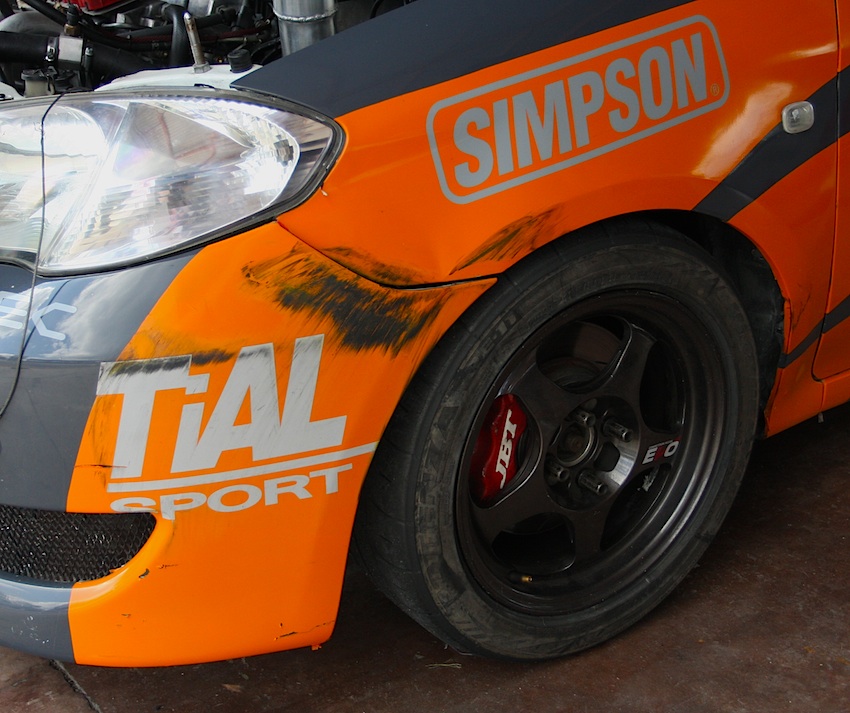 It doesns't look like much, but it was enough to shred a tire and bend the suspension.
It doesns't look like much, but it was enough to shred a tire and bend the suspension.
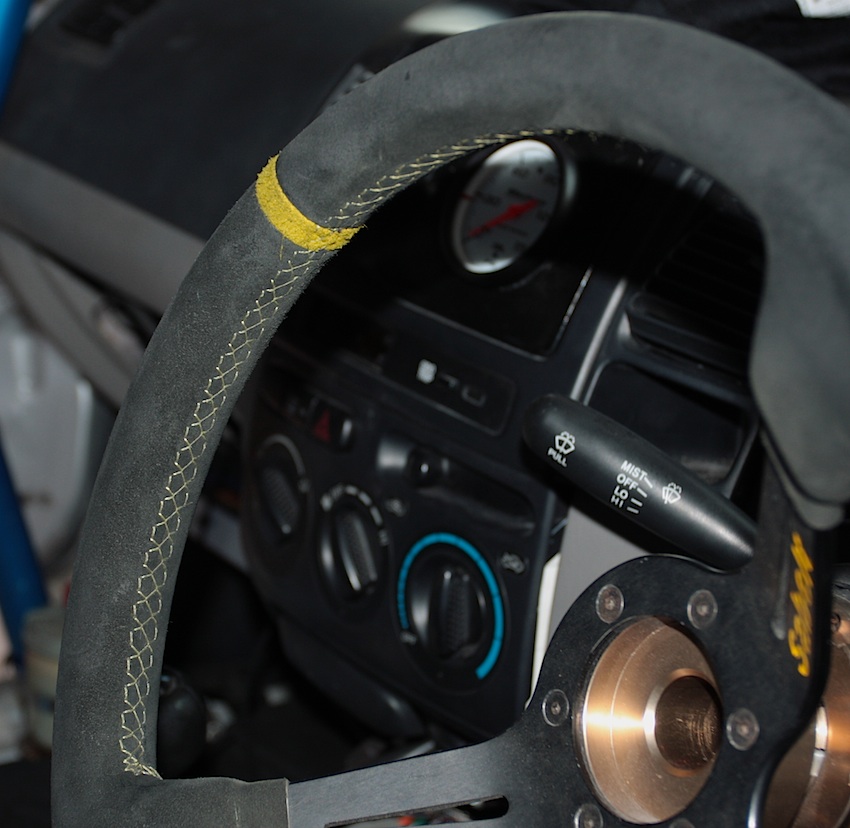 At the start of the race the yellow band on the steering wheel marked the "straight ahead" position. You can see how much things were bent with the new off-center position. No problem, he will repair and race the next day.
At the start of the race the yellow band on the steering wheel marked the "straight ahead" position. You can see how much things were bent with the new off-center position. No problem, he will repair and race the next day.
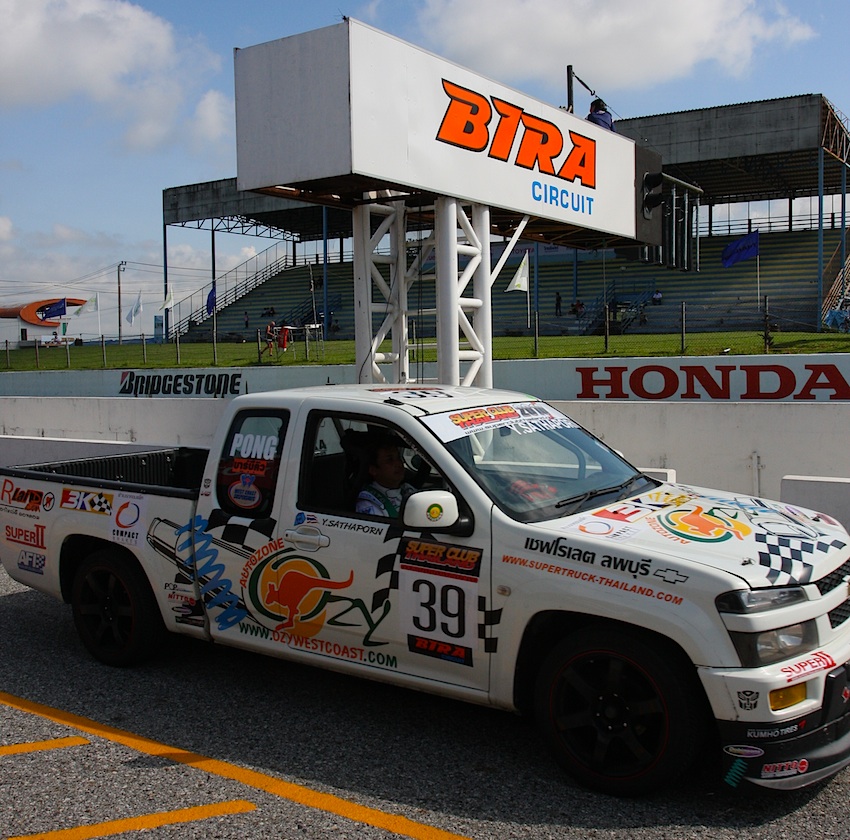 The Bira Curcuit is a very well run race track that offers racers many classes in which to participate. Like this Street Truck Class race truck . . .
The Bira Curcuit is a very well run race track that offers racers many classes in which to participate. Like this Street Truck Class race truck . . .
 To Retro Class . . .
To Retro Class . . .
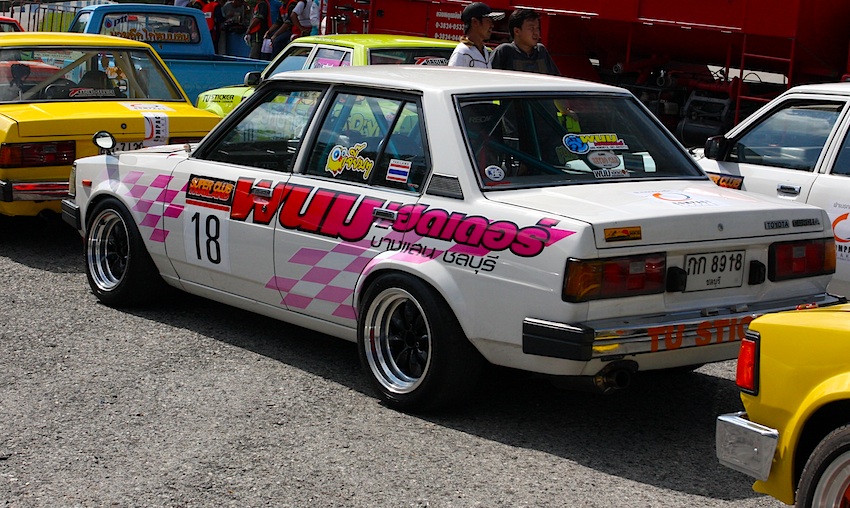 To more Vintage Race Class . . . .
To more Vintage Race Class . . . .
 To very serious purpose built radical race sedans.
To very serious purpose built radical race sedans.
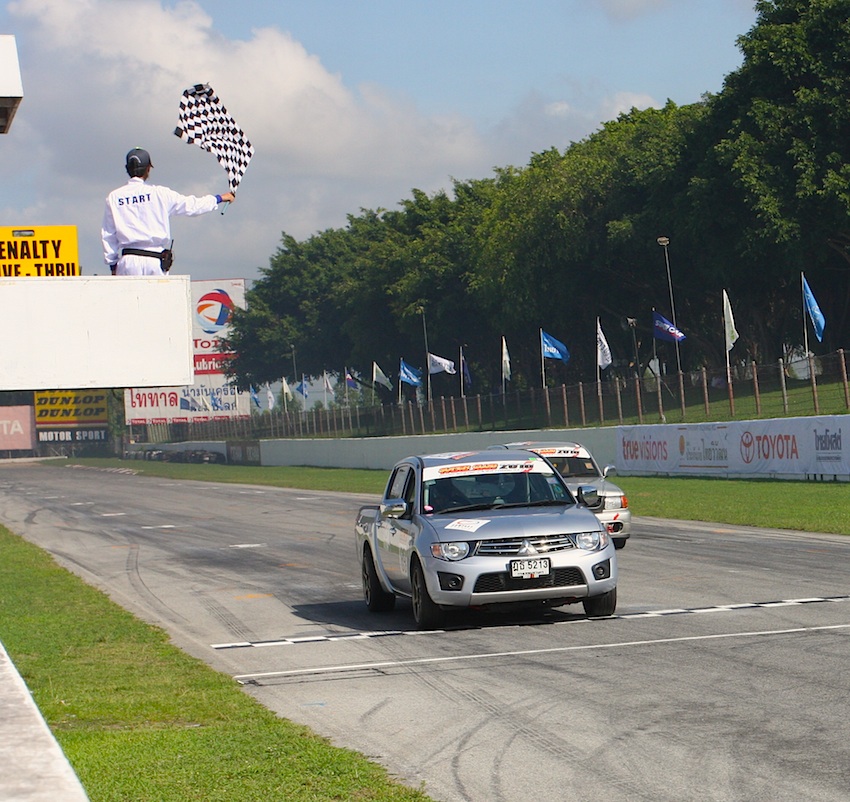 The many races are usually very close.
The many races are usually very close.
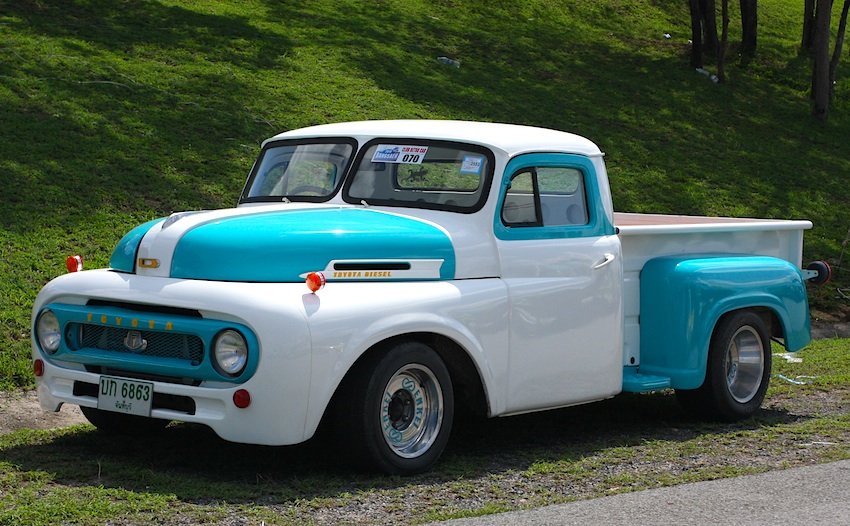 Race tracks attract guys and their cool cars. Like this beautiful old choppedd-top Toyota pick-up which was actually entered in the Retro Class.
Race tracks attract guys and their cool cars. Like this beautiful old choppedd-top Toyota pick-up which was actually entered in the Retro Class.
 Dr. Jeff Harper
Dr. Jeff Harper
I went back to Bira Circuit (near Pattaya, Thailand) today to see Khun Mac race again. This time I didn't bring him bad luck: he won his class. Here are the photo from today.
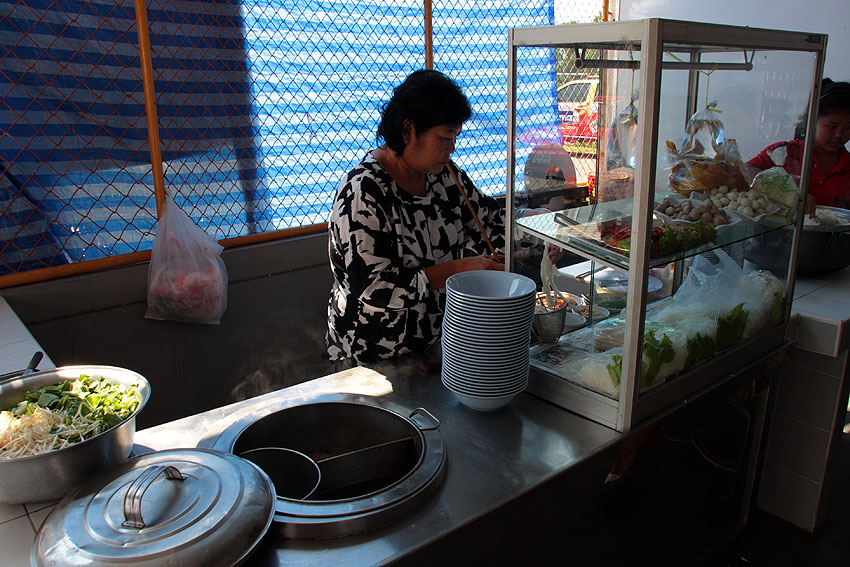 First of all, I have to say that Bira Circuit, and Bangkok Drag Avenue, have the BEST race track food in the world. There is nothing like hot and spicy Thai soup with fish balls and wide noodles . . . Need I say more!
First of all, I have to say that Bira Circuit, and Bangkok Drag Avenue, have the BEST race track food in the world. There is nothing like hot and spicy Thai soup with fish balls and wide noodles . . . Need I say more!
 The are more very well prepared race cars now, like this very nice BMW.
The are more very well prepared race cars now, like this very nice BMW.
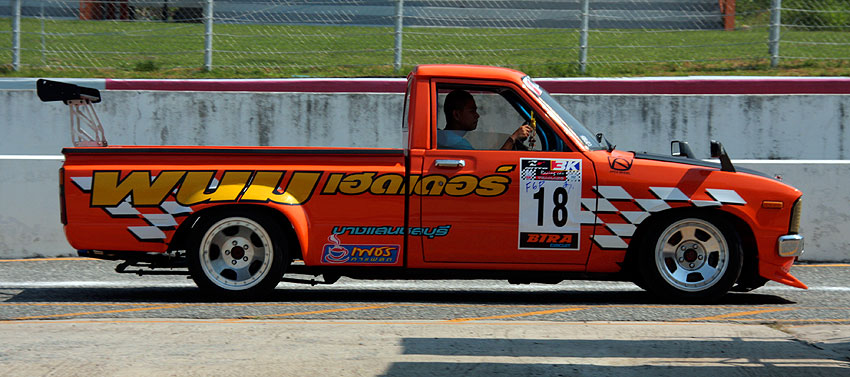 There are several "Retro" classes for cars and trucks. This one was very clean.
There are several "Retro" classes for cars and trucks. This one was very clean.
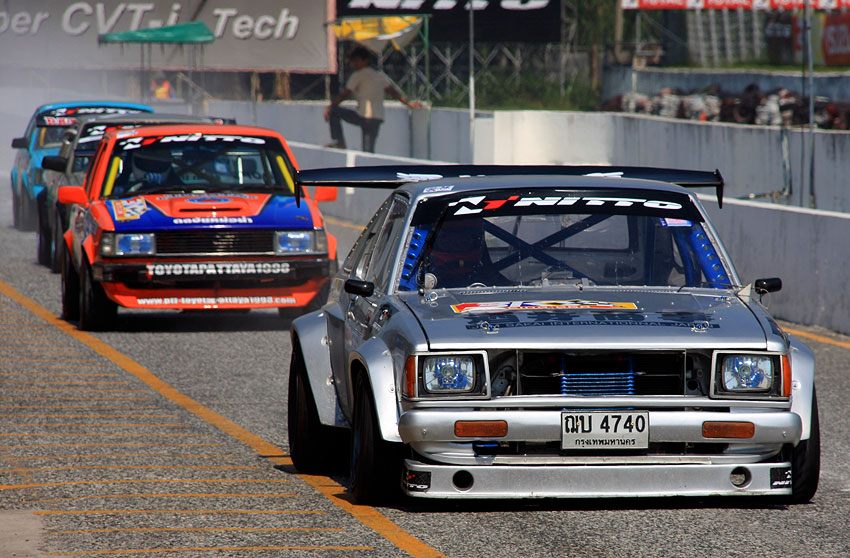 The racers have a lot of fun in these "run-what-ya-brung" classes. Most races get to race in two classes - qualifying and a race in each.
The racers have a lot of fun in these "run-what-ya-brung" classes. Most races get to race in two classes - qualifying and a race in each.
 Some of these Retro Class racers have a lot of modern technology (and 400hp!).
Some of these Retro Class racers have a lot of modern technology (and 400hp!).
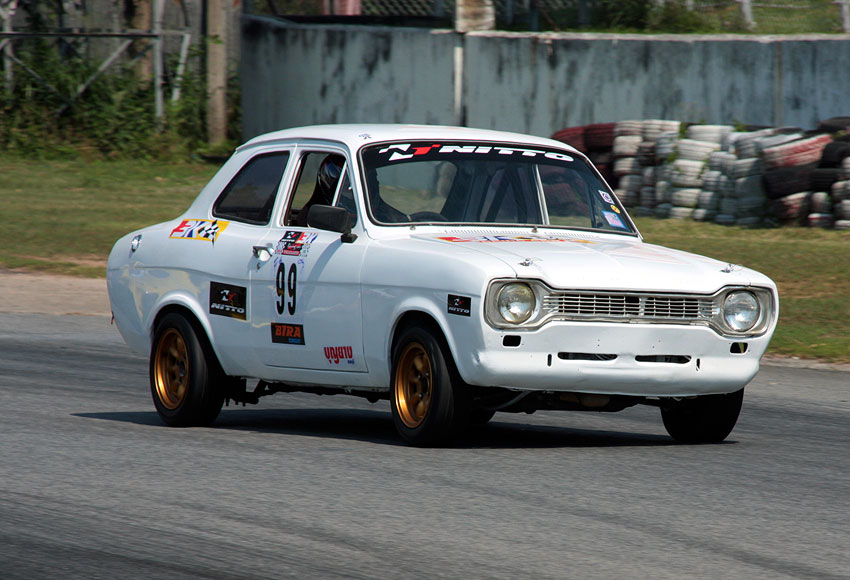 And some of the Retro Class racers go for perfect period accuracy.
And some of the Retro Class racers go for perfect period accuracy.
 Some Retro Class racers go for the period . . . but not perfect.
Some Retro Class racers go for the period . . . but not perfect.
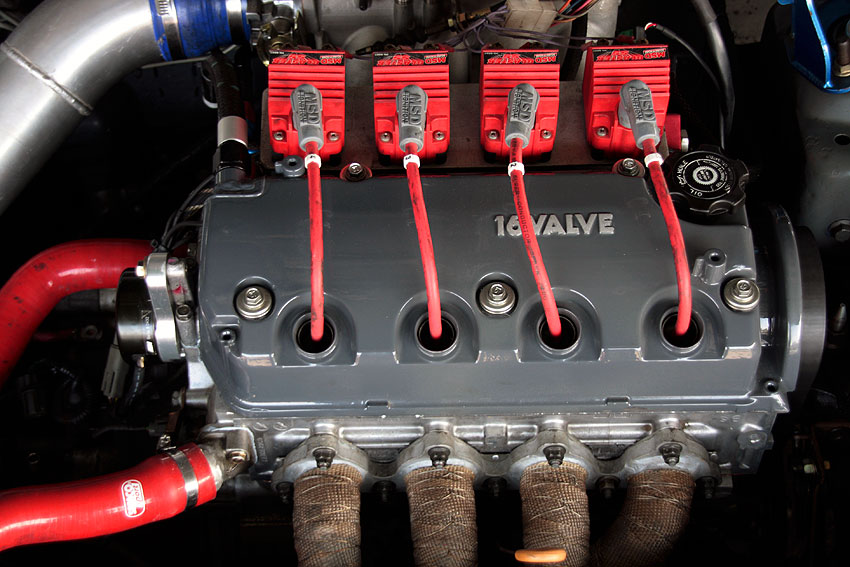 The pits are open, like at the drag races, and there is a lot to see.
The pits are open, like at the drag races, and there is a lot to see.
 Some teams were in a big thrash to get their cars back on track.
Some teams were in a big thrash to get their cars back on track.
 My friend Mac won his class today by a country mile.
My friend Mac won his class today by a country mile.
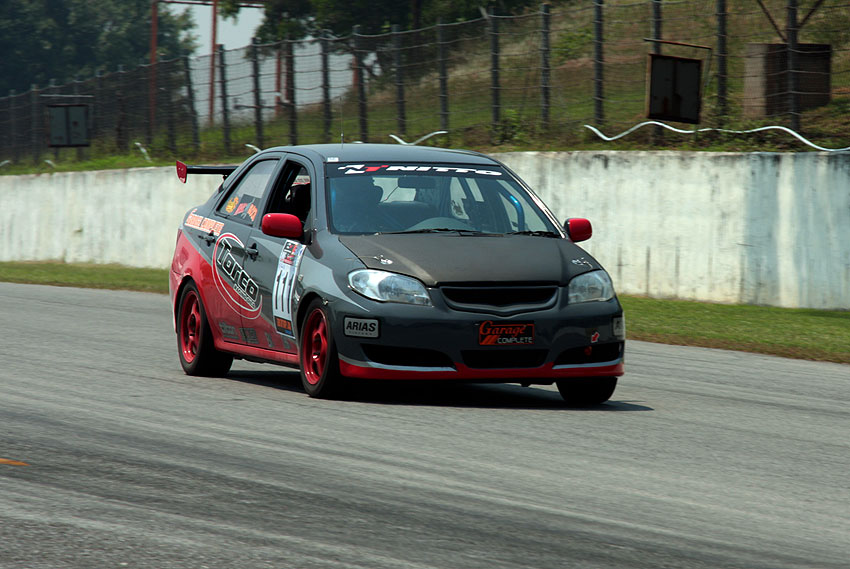 Here is Mac leading his race in his Torco-sponsored racer.
Here is Mac leading his race in his Torco-sponsored racer.
 He passed about five cars by the time he got through Turn One.
He passed about five cars by the time he got through Turn One.
 And a few more on the Back Straight.
And a few more on the Back Straight.
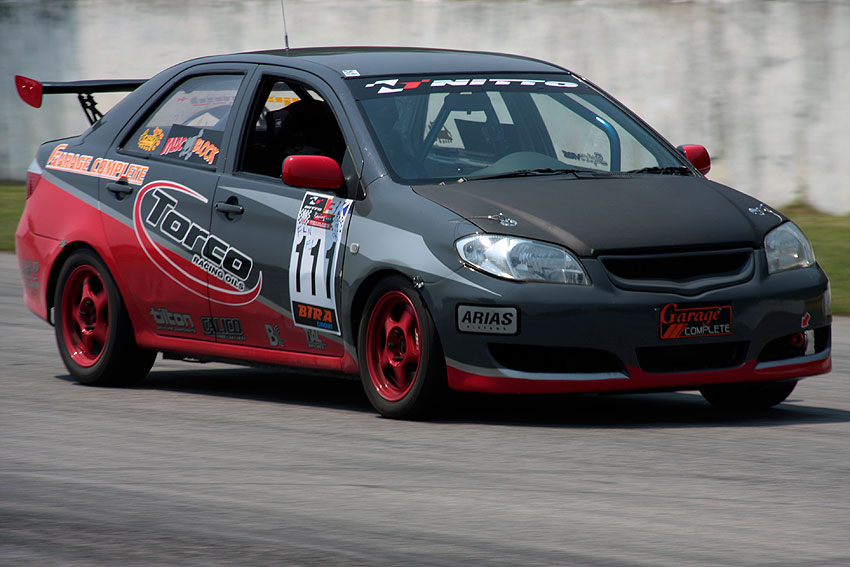 Here is Mac on his victory lap.
Here is Mac on his victory lap.
 The racing was tight in the truck classes.
The racing was tight in the truck classes.
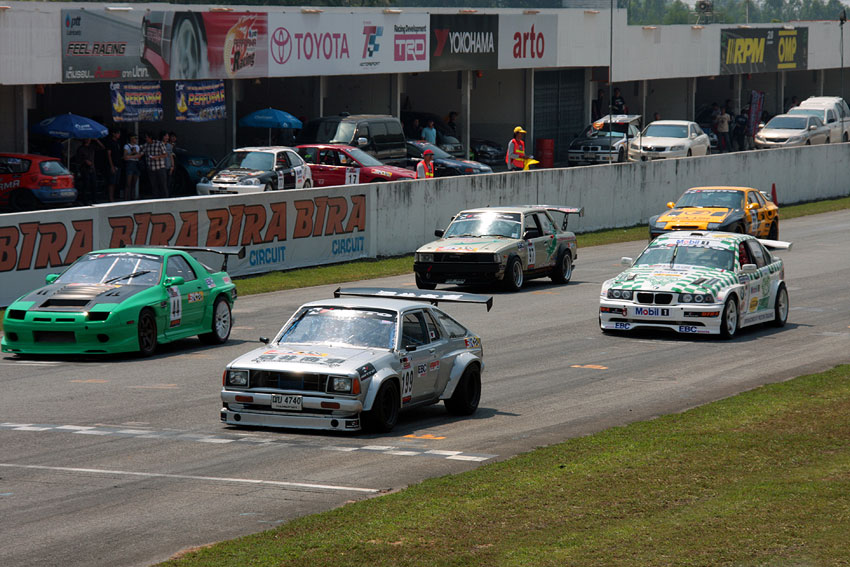 The faster, modified classes ran later in the day.
The faster, modified classes ran later in the day.
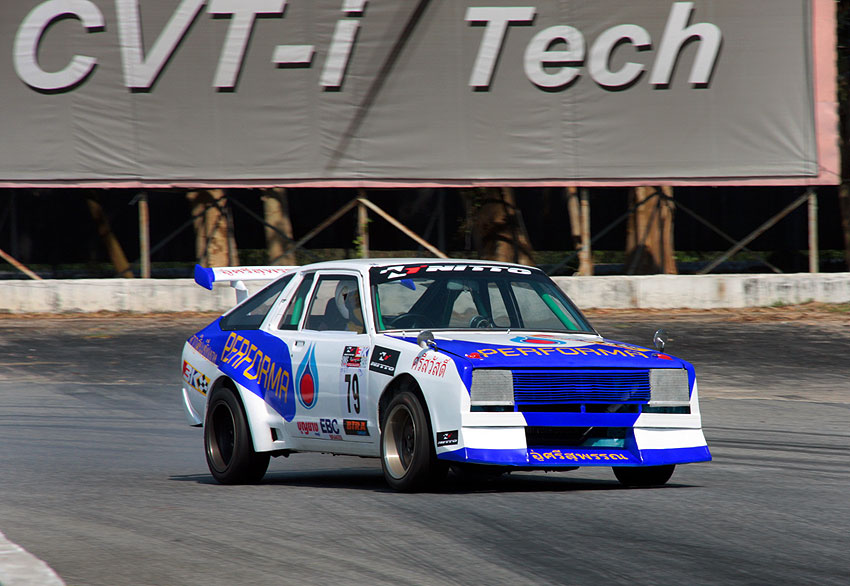 I had a fun day watching the races and enjoying the sound of the little four cylinder race motors at full song.
I had a fun day watching the races and enjoying the sound of the little four cylinder race motors at full song.
 Dr. Jeff Harper
Dr. Jeff Harper
Another fine Saturday spent cheering Khun Mac and team TORCO OIL at the Bira Circuit in Pattaya, Thailand.
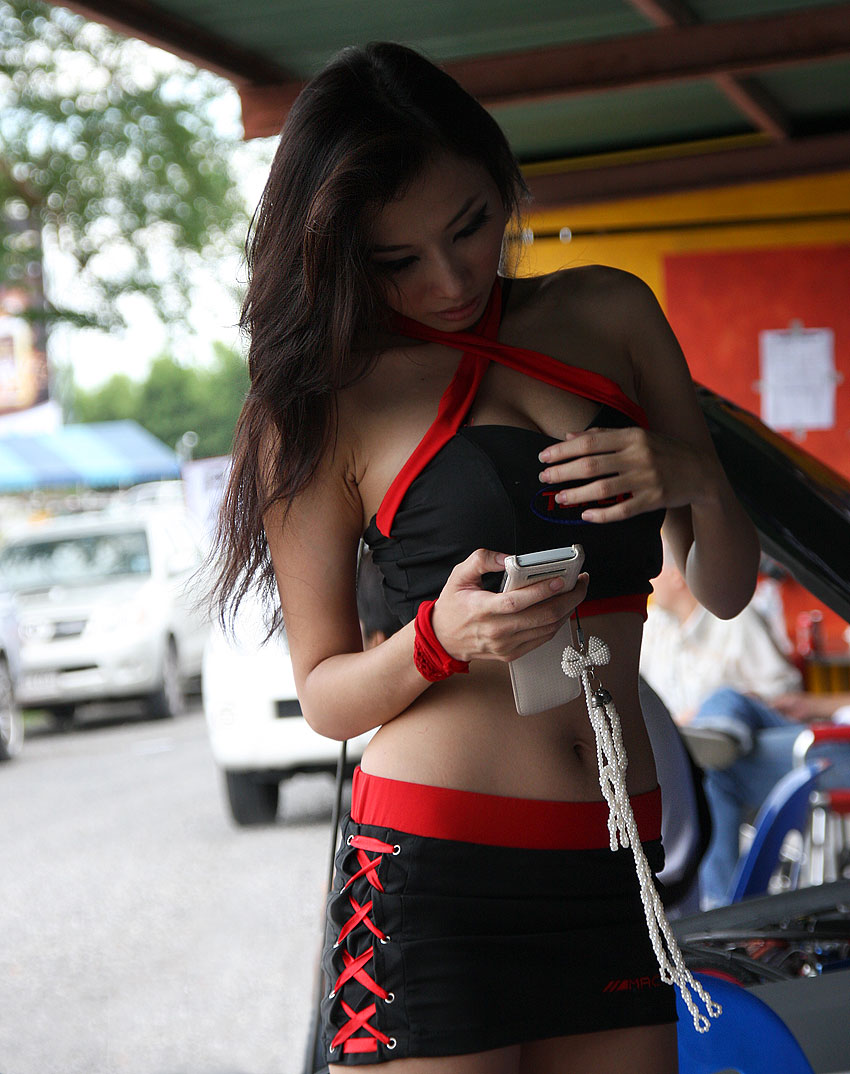
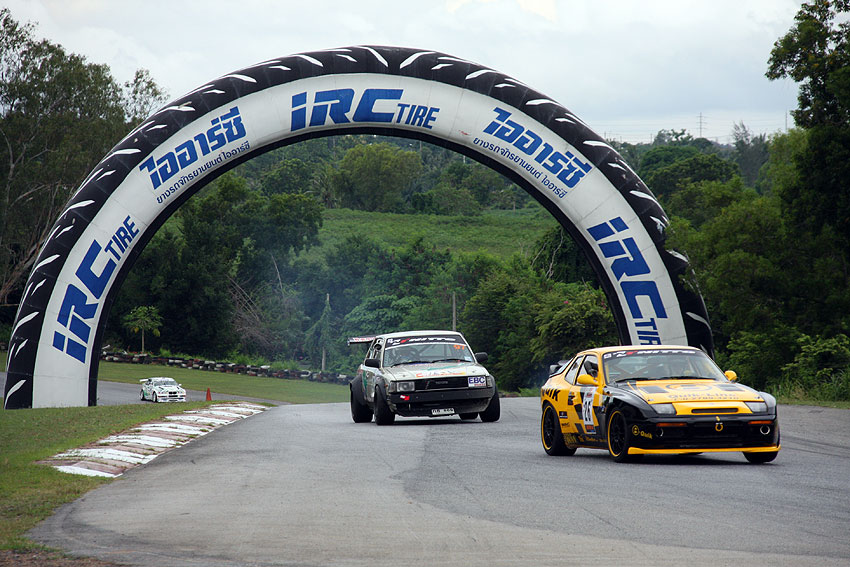
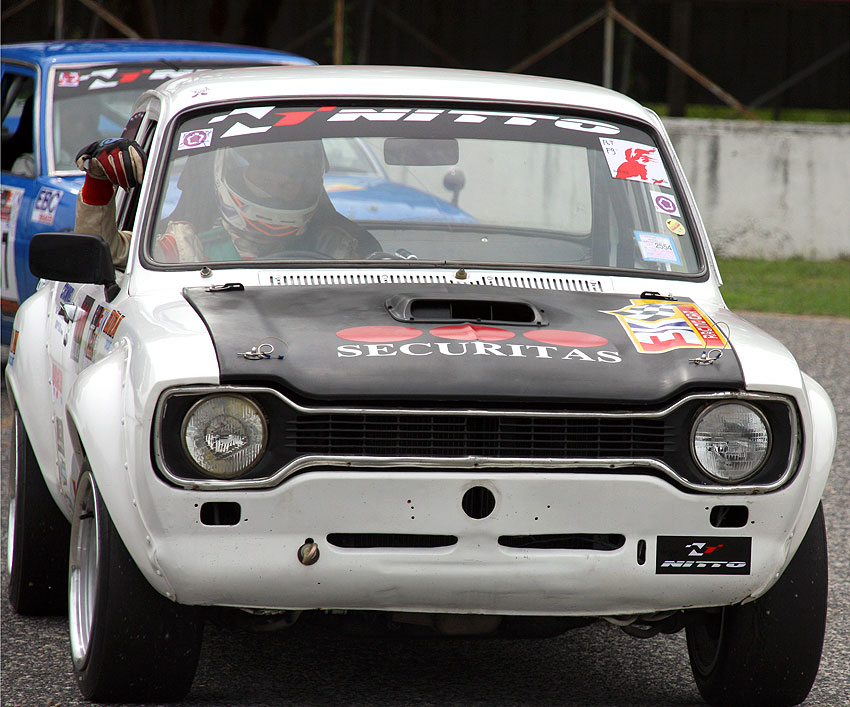
My new friend, The Good Doctor . . . . who has been racing for over 40 years - most of it in England. His racing goals are modest: to finish in the same position he qualified (15th in this case . . . he finished 13th and was extremely happy).
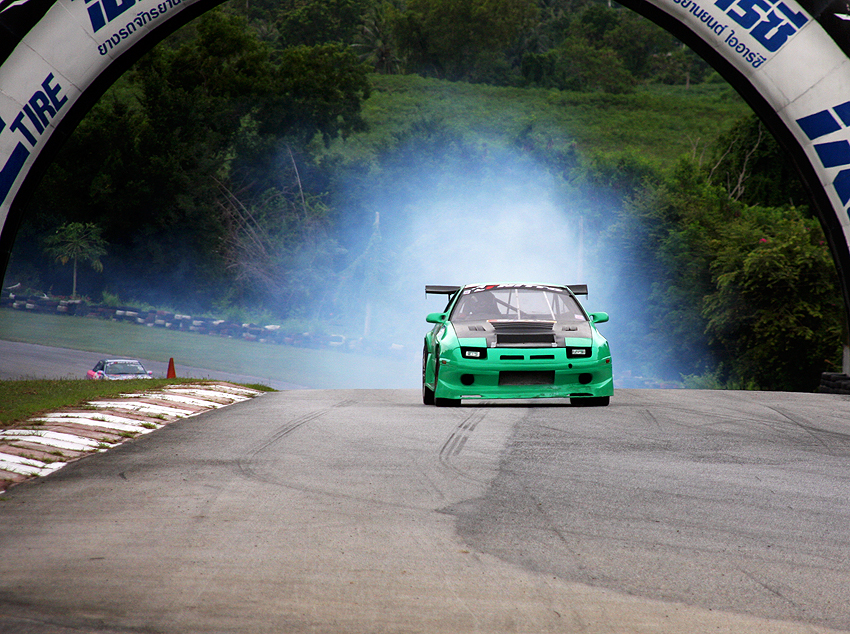
Not everyone was happy with their track day: a blown motor at speed. Ouch.
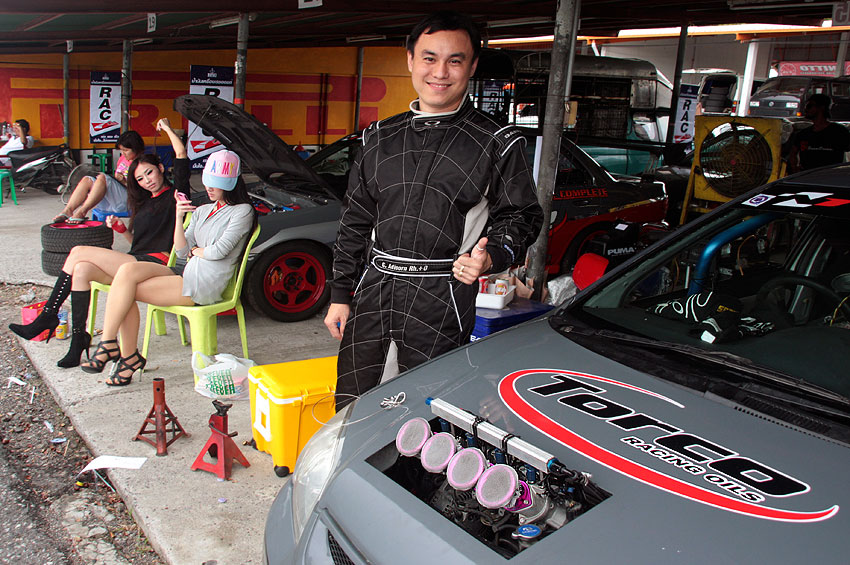
A smiling Mac . . either because of assembling the winning race engine in his race car, or for assembling a pair of Race Queens in his garage.
Where I Have Been Today - 06/06/2009
 Sunday, June 7, 2009 at 12:57PM
Sunday, June 7, 2009 at 12:57PM I am enjoying my life in Bangkok. I have been enjoying it for over 13 years now. I enjoy it as much as I did my 10 years in The Congo and my years in London and Singapore. One of the main reasons I enjoy it so much here is the "adventure in meaning" I experience almost every day: the spaces I find myself in. The "perception that comes only with estrangement" when looking up to say to myself, "Look where you are." Today was one of those days.
Here are the photos . . . the narrative will follow.
With my wife and her family at our family Buddhist Temple (Wat) paying respect to the memory of my and their recently departed mothers.

Monks moving about the temple - some construction on site - and some shoes.
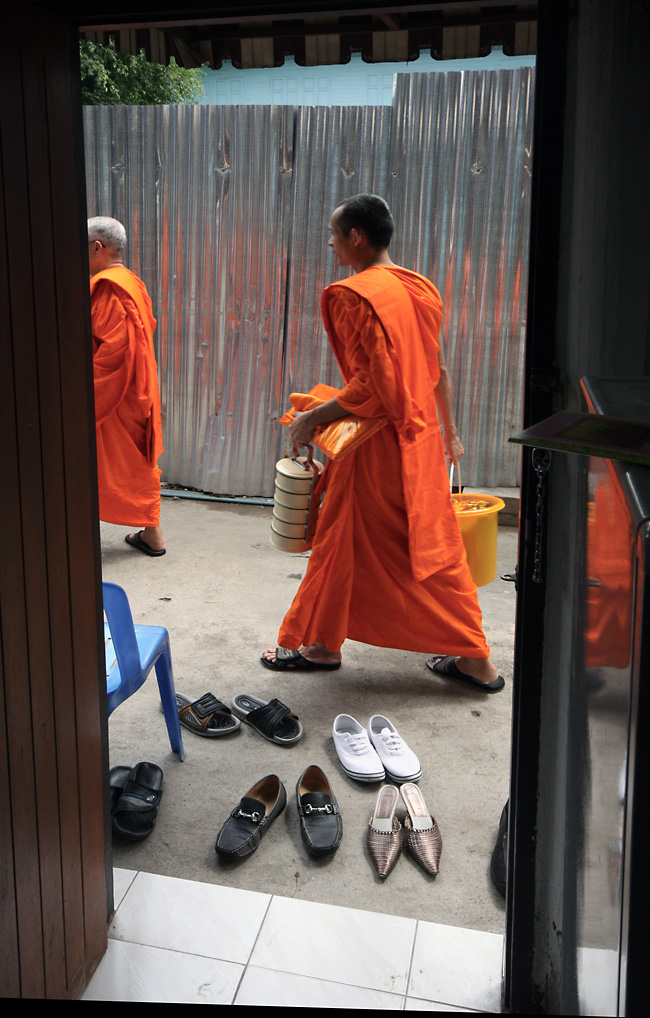
A quick stop for Starbucks at the Central Lat Praew shopping mall with my friend Richard. I picked up a supercharger from New Zealand from him and we had a nice conversation.
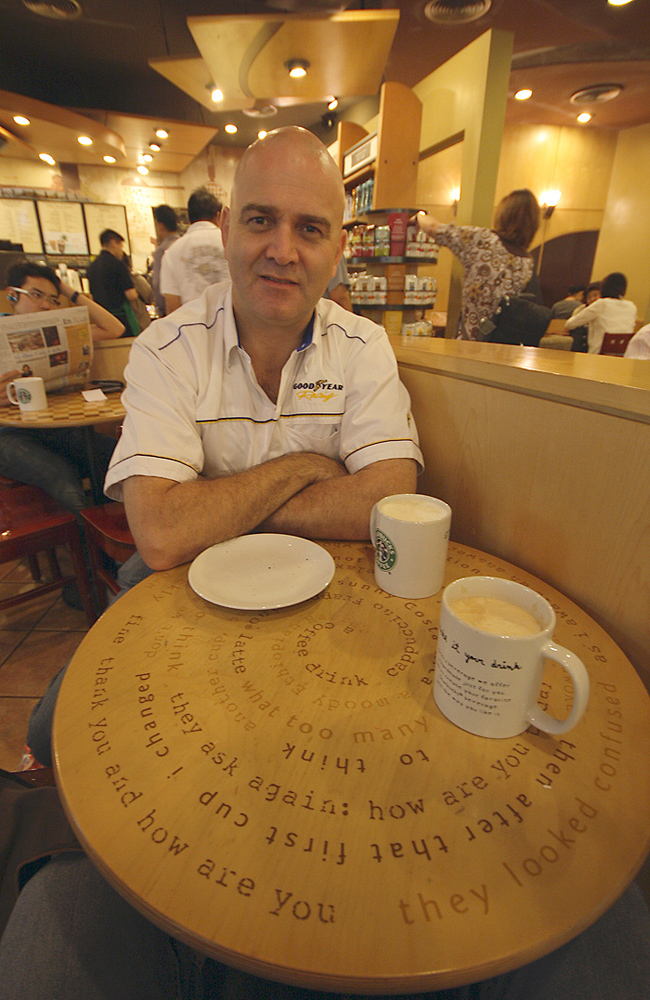
Another stop amid the labyrinthine side streets and alleys of Bangkok to a race car chassis shop to make arrangements to restart construction of another racing project - a drag radial class legal 1970 Ford Maverick. This shop mine as well be located in one of the white spots on the map of the earth; it is remote in every way. I feel as remote when I am here as I did when exploring the upper reaches of the Congo River in the late 70's.
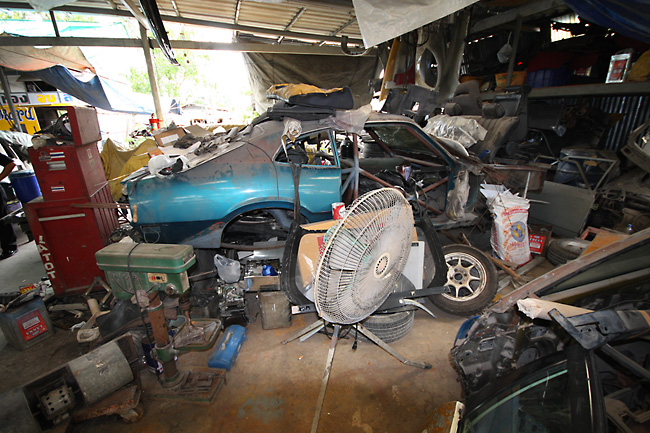
The race shop privy. 12:00 noon. June 6, 2009. Bangkok,Thailand.
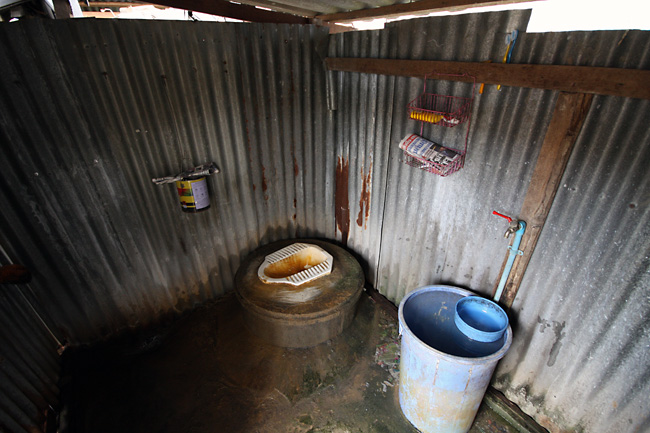
Fast food for lunch. Notice what is on sale here: a shrimp burger, a fried pork strip/rice and cabbage combination plate, Chinese dim sum, mashed potatoes/gravy/sausages, and Pepsi. I had the chicken steak on a bun. It was made from fresh chicken dipped in tasty sauce, but was so messy with sauce, oil, wet lettuce, and tomato that I could not keep it all between the bun and not on the table or down my arm, even with my 50+ years of burger-eating expertise.
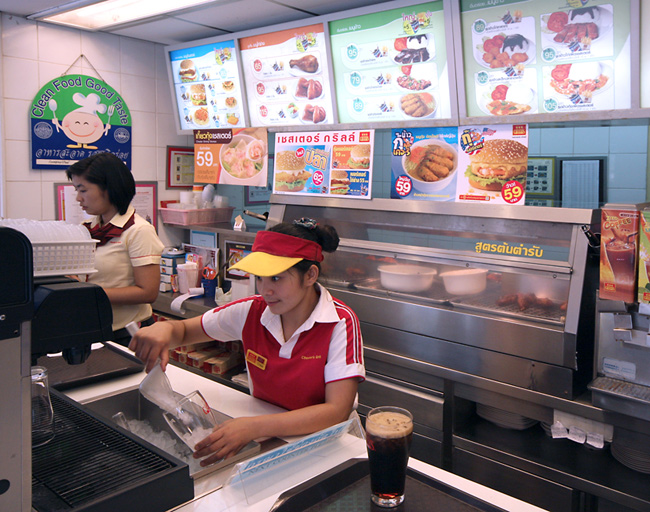
Another coffee stop . . and a rare indulgence for me - cherry cheesecake. I do not eat sugar or carbs . . . . . but a little now and again . . . The Thais have a great aesthetic sense: the design in the coffee foam is a piece of art.
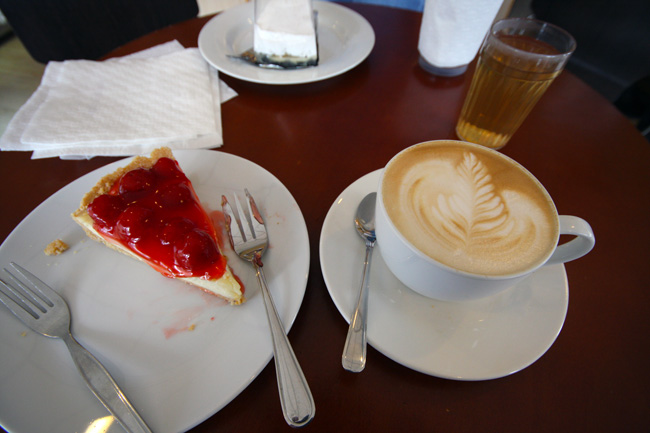
At my trackside race shop with Peter, my friend, chasing down an electrical gremlin that has kept me off the track for several weeks. We found the problem: mice had been gnawing the insulation off the wiring. I hate it when that happens.

I stood around in return lane with my friends 'bench racing' and admiring Andy's Bad Boy Street Racer Supra (BBSRS) wide body. I went home around midnight. It was a good day, filled with interest, some charm, friends, warm feelings, disappointment, and fun.

The Thai Market
 Wednesday, April 15, 2009 at 10:10AM
Wednesday, April 15, 2009 at 10:10AM A Walk in the Thai Market
Realism is the impossible attempt to view the world from Nowhere.
- Richard Rorty
Thailand, like most of the world, is beginning to be engulfed by the so-called global economy and the concomitant standardization of commercial space. Marketing plan driven corporate purchasing environments are the absolute antithesis of the Thai market, so far. The Thai market is a free-formed, organic, non-linear coming together of material items for sale, people, and culture . . . as well as light and shadow. The photographs that follow make clear that the light and shadow one encounters on a walk in the market tell a larger story; A story that will be different for each viewer, in the same way that the experience of the market for those who participate in its daily assembly and disassembly have different lives lived in its crowded confines that make each of their stories different, one from the other.
To walk in the market in Thailand is to be given the opportunity to ponder larger questions. It is a seemingly unavoidable necessity for the market visitor, first timer or old hand, to ask questions about what is being seen; to make sense. This compulsive drive for sense-making is not unique to the market, but is common whenever there is an encounter with other complex visual landscapes, such as the jungle, the coral reef, the human face. Upon entering the market there is, all of a sudden, so much unanticipated subject and object to think about. So much to feel; Information to process; Comparisons to be made; Differences to note and notice; Commentary to express. Your mind becomes as busy as the market environment itself. There around you are the strong images, arrangements, poses, still life portraits in the real, as it were, meant, you feel, for filing away in your visual memory to draw upon when the need for a memory of beauty is needed. You pay attention. You walk. Questions are begged. You think:
How has a thing come to be the way it is? How have all the forces of the universe so combined that such a thing is as it is?
-- James Agee
The mind of the market wanderer is full of wondering: What is going on here? What is going on here is not held in secret. Far from it, it is as explicit and overt as a freshly cracked ripe durian. To walk in the market is to find yourself asking questions. Making plans. Organizing thought. A study must be conducted. Curiosity must be formalized, one thinks, to get at what is so plainly present. An elevated discourse must be constructed, you say to yourself, to do justice to the people and place. Some comprehensive story must be made up, no mater how generalized it may start off. What is really going on here. The practical and the spiritual are to be found here. Everything that a person living in Thailand will want to buy is on sale. What is need to make or fix, wash or scrub, prepare or cook; every thing that supports or amuses, or is necessary for humans, or fancied by them, is here. The stuff of all local tastes and desires are to be found in the market. The questions arise, you walk, you think.

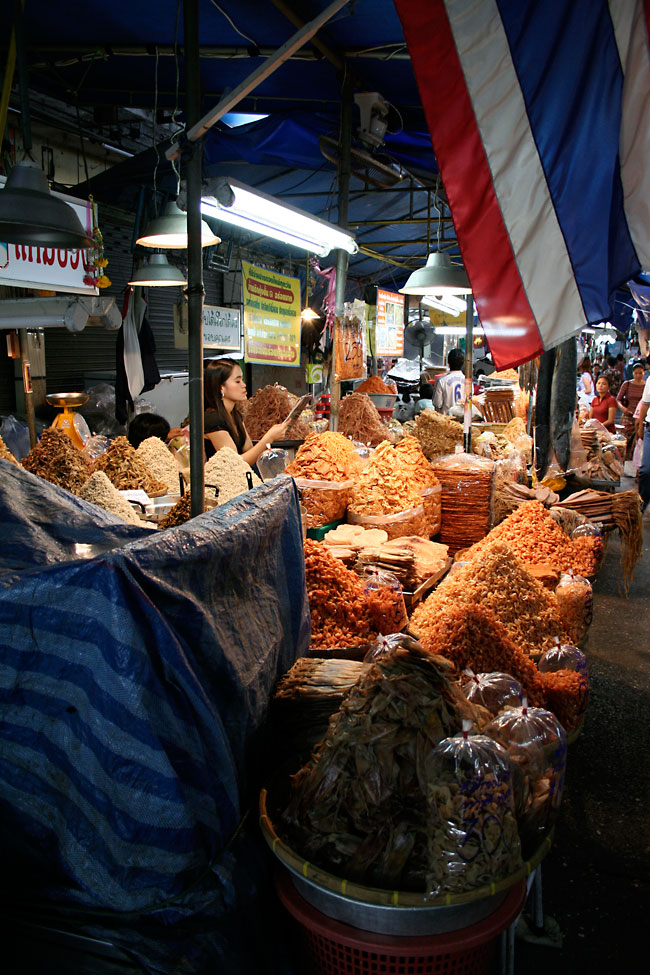
The Thai market is an abstract montage of things to look at and buy. The window dresser's calculus of knowing where to place an item to increase the likelihood of purchase seems shrouded in an ancient mystery here. The apparent jumble must surely relate to how a customer deduces a plan to find what is to be bought on any particular trip to the market. Or, at the very least, the arrangement must seem to the passer-by to be an irresistible inducement to set into motion the proverbial impulse purchase. There must be a logic, one assumes, to the arrangement of these things in space. Wouldn't there be? Wouldn't there have to be? The exact combination of what one particular petit commercant has on offer (on shelf, tub, hook, pan, basket) must surely relate to some locally agreed upon conceptualization of what goes together in order to help the purchaser find what they are looking for. But the sudden awareness you can have in the market when confronted with cheese framed faucets, cucumbers resting on rat traps, and the ubiquity-busting melons astride bras, is that perhaps no plan exists. You have to be a very smart shopper here.
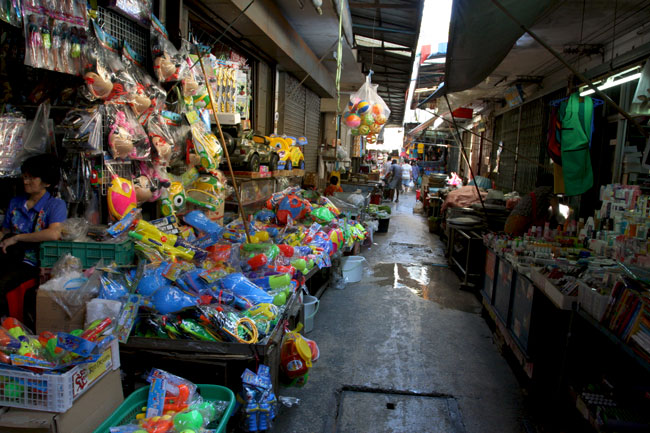
Arrayed in lines, circles, bundles, braids, entwinements, enwrapments, with and without geometry, you have the complete thesaurus' accounting of "display" and "array" in applied form right in front of you. And new ways of displaying, one suspects, being added daily as a result of the creative moments only one who sits in a hot market needing to make a sale to pay the bills would have. Or maybe not. Or maybe, it can look like, on a particular walk in the market, that the norm of display is the avoiding of conscious input into "promotion" of any item. That such a conscious intending would drive away the customer with hair-trigger resentments at being identified simply as a vulgar customer; a thing to buy a thing; other than human; qualified and identified by what is in a wallet or purse. What conventions are at work here on this day? What shared understandings about humanity are at work in the Thai market. How much spoken, how much left unsaid.
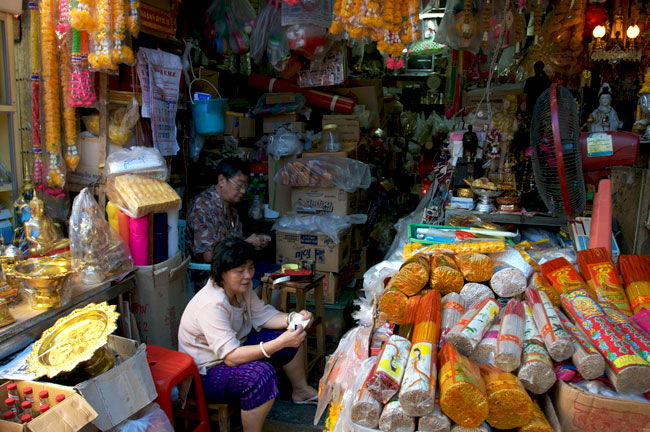
How does what gets offered on shelf, tub, hook, pan, basket, and cart get offered for sale, and why? How do the small merchants make sense of the market? Are bobbins and croissants side-by-side because of the observed rapid sales of such items? Is this market response? What theory guides these choices? Cheap availability only? Salesmen-promised big profits fast without risk and no obligation sign here now? Supply and demand? Surely not. There must be as many explanations for how what ended up on which cart, table, or tub as there are sellers in the market. Or, maybe, there are only a few ways to account for it. A simple set of forces that guide all these individual choices. Perhaps not.

What characterizes the Thai market is the reality of human lives lived in public. The market is where the much-admired Thai civic culture is practiced, learned, replicated, and appreciated.
Since every religious and cultural tradition has some component of authentic (civilization-transcending) universalism, this sets the stage for the struggle in every society between those who have an intuitive experience of authentic universalism, and those who equate species identity with their own historical sense of mission.
-- Elise Boulding
What can be captured in a glance? What human moment can be eavesdropped upon among the commotion? What vignet of human joy or agony, or subtle dissatisfaction or kindness are we reading as we look around? How do we pick out what is recognized, or recognizable? Why this laughing child and not this father and son in intense conversation? The lives of the marketeers are public lives. Lives lived in public, warts and all, as they say. Here one has a profound experience of what has gone missing in much of the overorganized countries: people in public. The human cavalcade. All the stations and expressions and situations and relationships . . . almost the entire realm of possibility of human experience lived out in the market. To stand in the blur of the market, letting a scene come into and then out of focus, one after another, from fish heads to grandmother's head, is like living in a wide-awake dream. Images pass and come again as whole landscapes of meaning and mystery unfold, briefly unpack themselves just for you, then pass, with you having been the only witness to some beautiful expression of actuality. Again and again. It is, as Thomas Wolfe said, an adventure in meaning.

And language. What is taken away from an experience in the Thai market will, of course, relate to whether or not you, as a visitor (or regular), speak Thai, and, if so, to what level of comprehension. Thai people must be the least xenophobic people on the planet. They make the effort to accommodate the stranger and to make him or her feel comfortable. Getting along is the national pastime. Jai yen yen. Avoiding conflict in public is the national obsession. Mai pen rai, is the national motto.
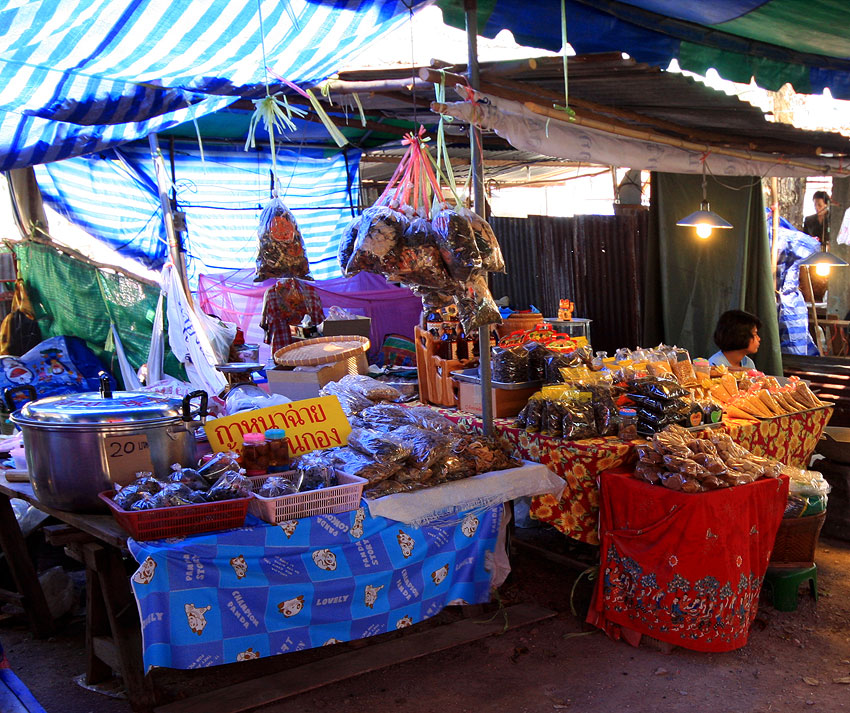
And where do all of the items for sale come from? How did they get here, to this place, today? The Thai market extends as a living, moving web of connections to those who are making, manufacturing, growing, raising, crafting, assembling, producing, processing, carving, painting, pressing, sieving, stuffing, spooling, shaving, stacking, staking, skewering, separating, segmenting, and all of the other incredible variety of activities and movements humans do while in the act of producing. Human Artifacts From The Hands Of Humans For Sale Here.
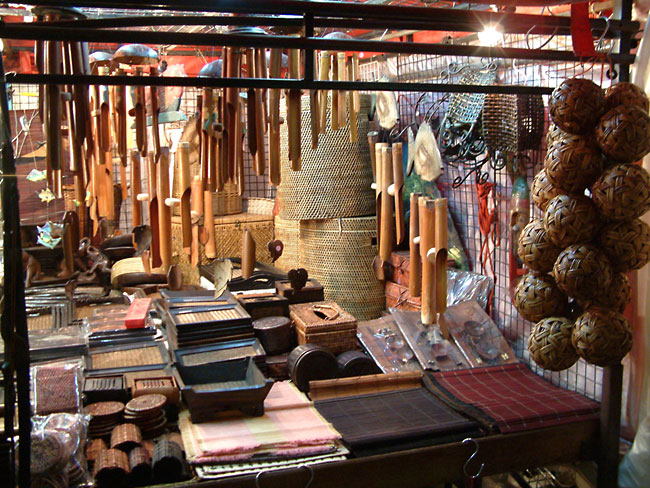
There seems to be something about being in a place devoid of sophisticated marketing ploys and capers (the Sirens of the Purchasing Event) of the modern superstore that enables the market visitor in Thailand to obtain the distance, the estrangement, from the product-without-a-history view of merchandise necessary for a glimpse into the relationship between what is made, who makes it, how it is made, who sells it, and who buys it - of every thing. The clean, white container of Johnson's Baby Powder (astride the squid brochettes) seems, for the first time, made. In contrast to the human environment of the market, the far away big city art-department packaging graphics begin to be recognized as artificially interesting as they really are. The translated Chinese product labels found here are preferred: Happy Future Nails, Good Winning Cherry Blossom Soap. The napkin back and dining room table graphics are perfectly appropriate to the product and the market. The Thai market provides an escape from branding projects. Although it is pecuniary space, it has a face with whom you can interact.
What physically constitutes a market? What counts as a market? Lashed together canoes with pots and chewing gum and whatnot brand fish sauce, certainly. Seven circled food carts at 3:00am, oh yes. Acres of big business man controlled, all under one roof, stalls-for-rent, permanent structure, normally. Four streetside women with nine wash tubs filled with greens, sure. Carnival gold fish in a plastic swimming pool, o.k. A pick-up truck overhung with plastic bags of unidentified fruit, in synchronized sway, squeaking through your moo baan, of course.
There must be politics here. There are stories about bribes, kickbacks, dirty deals, cheats. Who decides who gets the prime locations in the market, and how? Is there turf to watch out for? Are there difficult personalities to watch out for and personages to please. What history of accommodation has forged the daily drill and discipline?

There are orange lines of monks to feed in the morning market who bless the market faithful.
What would it be like to live and work in the market? Every day? For the rest of my life? The rest of my life, how long will that be? The curiosity, questioning, sense-making has no end. The experiences in the market are never repeated. The human interactions are unique every time you go there.
For all the many years I have walked in markets around this planet (Africa, Europe, Egypt, India, China, all of Southeast Asia) I am still always in a swirl of amazement when I go there. The volume on reality seems turned way up. The world here is in fantastic 3-D; in fullest relief. My perception and awareness are in a fine and bold rejuvenating state. To walk the market is to experience a renewal of reverence for being. When you leave the market you take with you something new.
Oh yes, sometimes you go to the market to purchase things.
When I walk the market with my camera I am working. Working at seeing. Working at understanding, using images as the stuff of knowing. Performing the tasks of confirming and undoing presuppositions about what makes up reality (re: doing therapy on my common sense): Adding to and revising old stories and, perhaps, if I allow the perception that only comes with estrangement, making new stories for myself about the way it is. In this I is no different from anyone else walking the market; the tourist, the traveler, the Thai out-of-towner, the local policeman, the under foot child of the petit commercant,or customers on purchasing missions.
The photographs that follow are not necessarily supporting salvos, on behalf of the photographed, in a struggle against oblivion. Instead, they seem more likely to be lessons in how to overcome the compulsion to find pattern in the human fact; visual aids for the teaching of nominalism (there is only the small stuff); advertisements for the supramundane (what The Buddha did), than traditional art-photography visual penetralia (surface can be used to reveal that which is hidden behind surface). They digital Ohs and Ones cast upon Cyberspace. Colored light projected on glass or plastic for the viewer, whether ever having been in Thailand or not, to enrichen the self.
Jeffrey P. Harper, Ph.D.
Pakkret, Nonthaburi, Thailand
April 2002
[In 2001 and 2002 I accompanied the photographer Paul Ubl around Thailand while he took remarkable photographs of the Thai market for his book "A Walk in the Market" which was published in 2002. The preceding is the full text of the forward I wrote for that book, subsequently edited by the publisher. JPH 3/2009]
